Vol. 68, No. 11 (2019)
2019-06-05
INVITED REVIEW

2019, 68 (11): 110701.
doi:10.7498/aps.68.20190341
Abstract +
Due to the capability of nanoscale manipulation of photons and tunability of light-matter interaction, polaritonics has attracted much attention in the modern physics. Compared with traditional noble metals, two-dimensional van der Waals materials provide an ideal platform for polaritons with high confinement and tunability. Recently, the development of scanning near-field optical microscopy has revealed various polaritons, thereby paving the way for further studying the quantum physics and nano-photonics. In this review paper, we summarize the new developments in two-dimensional polaritonics by near-field optical approach. According to the introduction of near-field optics and its basic principle, we show several important directions in near-field developments of two-dimensional polaritonics, including plasmon polaritons, phonon polaritons, exciton polaritons, hybridized polaritons, etc. In the final part, we give the perspectives in development of near-field optics.
GENERAL
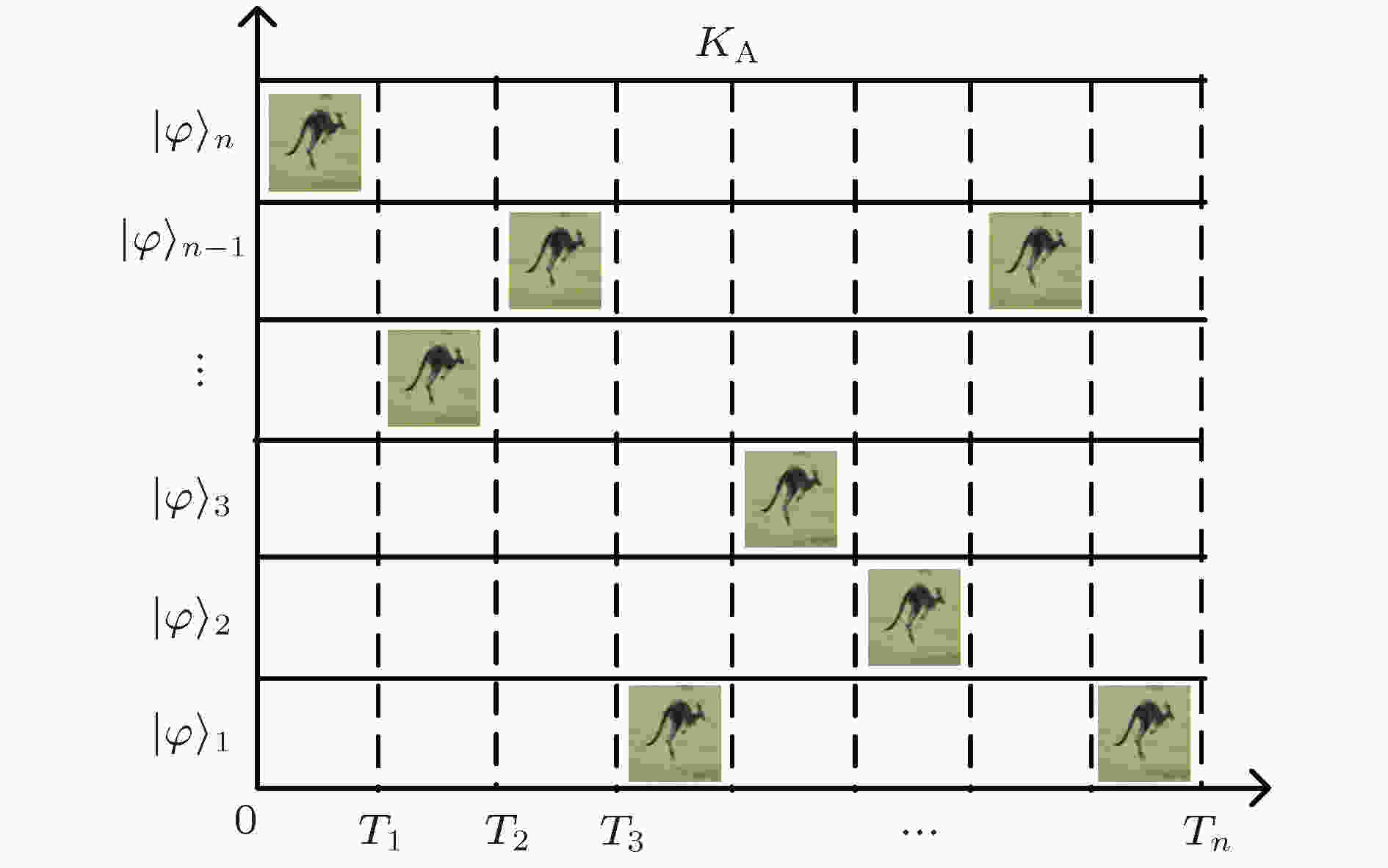
2019, 68 (11): 110301.
doi:10.7498/aps.68.20190163
Abstract +
Quantum communication in free space will be disturbed by natural environment such as fog and dust. However, to build a global quantum satellite wide area communication network, we must solve the problem of 24-h all-weather communication between satellite and earth. With the evolution of time, the degree of interference becomes deeper. In order to improve the performance of quantum communication under such an interference, in this paper we analyze the change of single quantum state channel over time under the background interference, and propose an quantum state-hopping communication strategy based on the kangaroo entanglement hopping model (KEHM), and simulate the performance and parameters of the strategy. Kangaroos are social animals. When they are frightened, they will jump synchronously in the same way with the same step length, height and frequency. According to this model, we make the two communicating parties realize synchronous quantum state jump according to the prearranged pattern. The simulations show that when the ratio between the average power of background quantum noise and the average power of quantum signal is 5, the quantum bit error rate decreases from 0.4524 to 0.1116 with the quantum state hopping frequency increasing from 1 to 15. When the single quantum state transmission success rate is 0.95 and the quantum bit rate is greater than 200 qubit/s, the probabilities of successful transmission of quantum bits at different state hopping frequencies are greater than 0.97. When the quantum reception efficiency of the receiver is 0.8, the quantum state pass rate increases from 0.3667 to 0.9986 with the average quantum number of the source increasing from 1 to 10. When the average quantum number of the source is 6, the passing rate of quantum state increases from 0.6262 to 0.9855 with the quantum receiving efficiency of the receiver increasing from 0.2 to 0.99. However, if the average quantum number of the transmitter is large enough and the receiving efficiency of the receiver is close to 1, the passing rate of the quantum state is also close to 1. The adaptive control strategy of quantum state hopping is based on real-time quantum channel state detection. Its core idea is to remove the quantum states which are seriously disturbed from the quantum state hopping set, and to realize the synchronous hopping of communication parties on the quantum states with low interference. Adopting the strategy of quantum state hopping adaptive control can further reduce the quantum bit error rate of the system. The error rate gain of adaptive control system increases with the increase of the success probability of processing the disturbed quantum state. When the probability of processing the disturbed quantum state is 0.95, the system error rate gain can reach 1.301. The performance of quantum state hopping system is improved obviously. To sum up, the adaptive quantum state-hopping communication strategy based on the kangaroo entanglement hopping model proposed in this paper greatly enhances the comprehensive immunity of the system and ensures the security of quantum information network, and provides an important reference for the healthy development of wide-area quantum satellite communication network in the future.
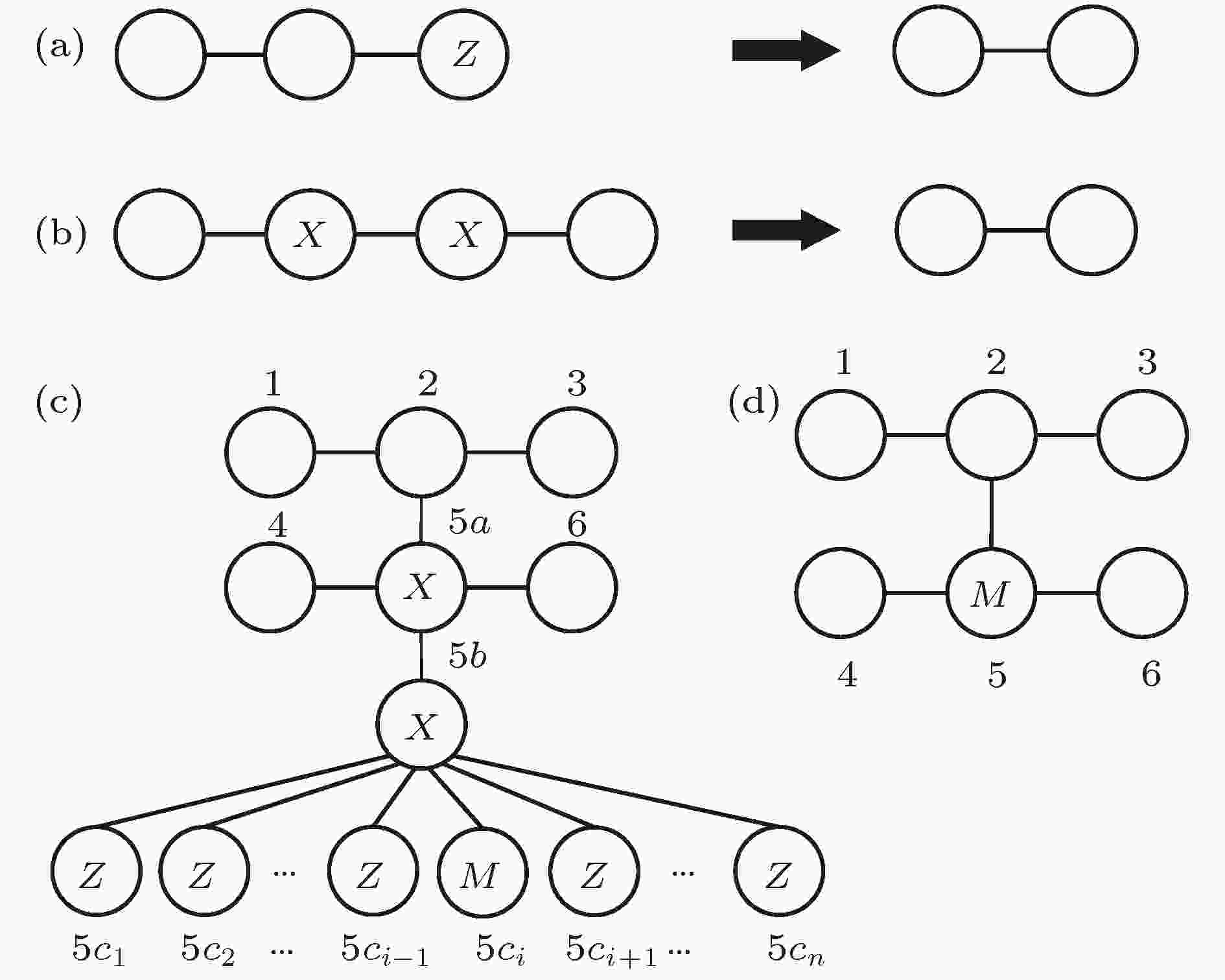
EDITOR'S SUGGESTION
2019, 68 (11): 110302.
doi:10.7498/aps.68.20190142
Abstract +
Quantum computation is a computing model based on quantum theory, which can outperform the classical computation in solving certain problems. With the increase of the complexity of quantum computing tasks, it becomes important to distribute quantum computing resources to multi-parties to cooperatively fulfill the complex tasks. Here in this paper a scheme based on the one-way quantum computing model is proposed to realize collaborative quantum computation. The standard one-way quantum computing model is based on graph states. With graph states used as resources, one can realize a universal quantum computer through using single-qubit measurements and feed-forward. In contrast to the standard one-way computation, the main resource for collaborative quantum computation is a redundant graph state (also a multi-particle highly entangled state). Unlike in the traditional graph state where each particle corresponds to a specific node, in a redundant graph state, several particles correspond to a single node, which means that each node of the graph has several redundant copies. With the help of a redundant graph state, several parties can share a graph state flexibly at will. A redundant graph state is prepared and then distributed to several parties where each of them obtains a full copy of all nodes. By communicating with each other and measuring the particles in different ways, a standard graph state is prepared and distributed among these parties. The collaborative computation then finishes through the common one-way quantum computing operations. Besides the general scheme, a concrete optical implementation of a two-party cooperative single-qubit quantum state preparation based on a six-photon redundant graph state is also put forward. Such a redundant graph state is proposed to be prepared by using the spontaneous parametric down-conversion entangled source and quantum interference. With this redundant graph state, a standard three-node graph state can be shared with the two parties in an arbitrary way. This scheme does not only make the collaborative quantum computation across several parties possible and flexible, but also guarantee the privacy of each party’s operations. This feature would be particularly useful in the case where the computing resource is obtained from an outside provider. This scheme paves the way for realizing quantum computation in more general and complicated applications.

2019, 68 (11): 110501.
doi:10.7498/aps.68.20190171
Abstract +

2019, 68 (11): 110502.
doi:10.7498/aps.68.20182264
Abstract +
In this paper, a new method of encrypting a color image based onθmodulation is proposed by using the tricolor principle and computer-generated hologram (CGH) technology. The encryption process includes theθ-modulated three primary color components and the coding of computer-generated hologram, which is implemented in a Fresnel diffraction and spatial filtering system. Firstly, the color image modulated by the first random phase key is divided into three encryption channels by red laser, green laser, blue laser, and tricolor filters. Each channel is introduced by a transmissive amplitude-type sinusoidal grating with different directions, which is used to separate the three primary color components in the spatial spectrum plane. Secondly, the modulation results of tricolor components are superimposed together to form a compound image, and the phase truncation of the superposition result is performed to achieve the asymmetric encryption. Finally, the amplitude of the compound image is modulated by the second random phase key and is encoded into a binary real-value gray-color CGH by Roman-type coding method. Therefore, the gray-color information of the original image is completely hidden in the encrypted CGH, which is more general and deceptive in the storage and transmission process. Decryption is an inverse process of the encryption. Firstly, the encrypted CGH is placed on the input plane of the spatial filtering and Fresnel diffraction system. Secondly, the demodulation of CGH phase key and the spatial filtering based on optical filter are performed. Finally, the color plaintext image is obtained by using the correct Fresnel diffraction. The simulation results show the validity and feasibility of the proposed method. In addition, the anti-noise attack and anti-shearing attack performance of this color image encryption method are investigated. Compared with results from the three presented methods reported in the literature, our investigated results demonstrate that this method has good robustness to noise attack and shearing attack, and has obvious advantages when the attack noise density is larger. Due to the characteristics of high security and anti-noise, we believe that this color image encryption method promises to have important applications in the information transmission and multi-user authentication.
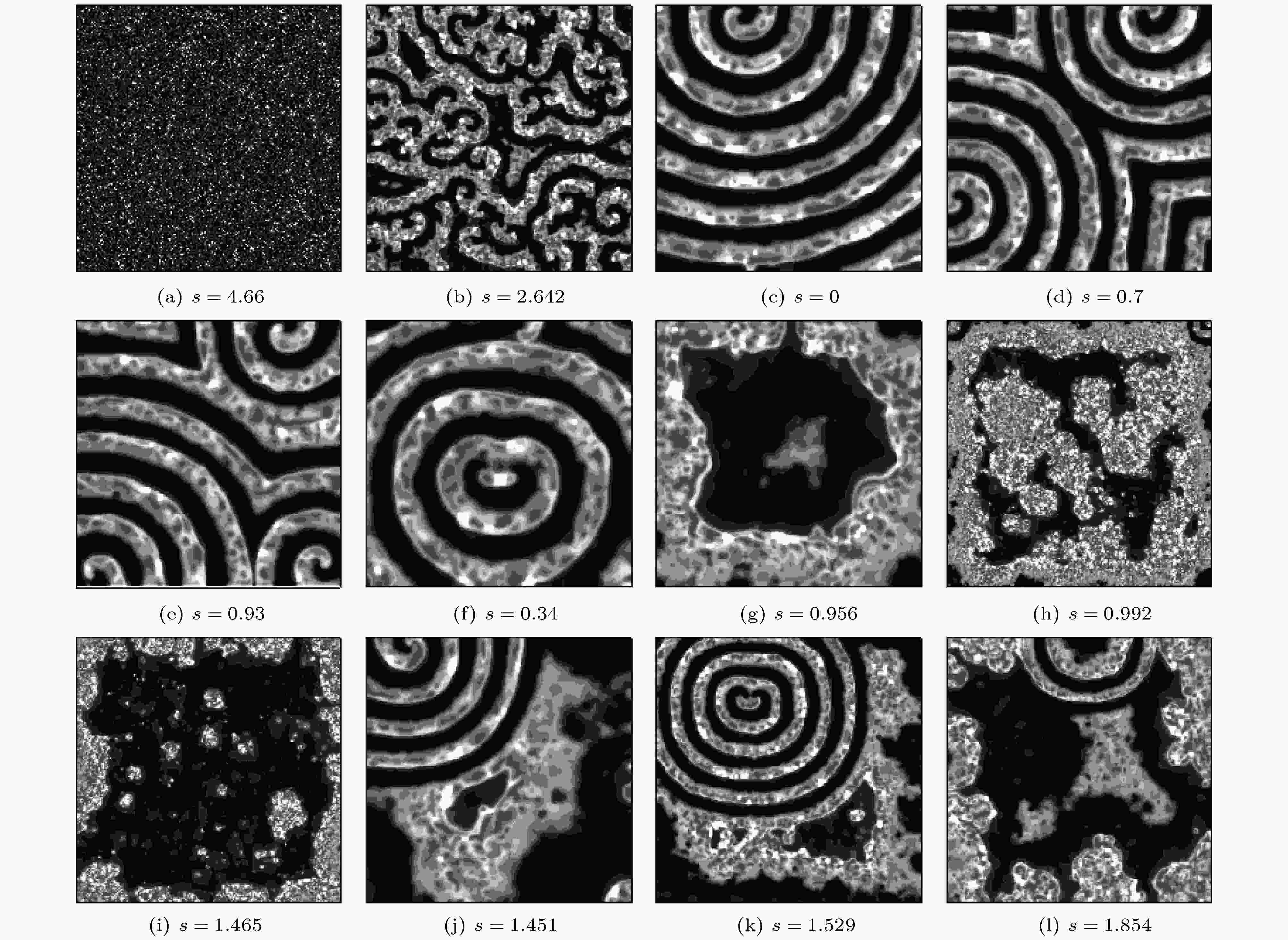
2019, 68 (11): 110503.
doi:10.7498/aps.68.20190231
Abstract +
Traveling waves, standing waves, and spiral waves occur spontaneously in the brain neural network in some brain states. The occurrence of these ordered spatiotemporal patterns is often related to some neurological diseases. However, the mechanisms behind the generation of the ordered pattern are not fully understood. How to quantitatively describe the nature of these spatiotemporal patterns still needs further exploring. In order to solve these problems, the Hindmarsh-Rose neuron model is used to study the dynamic behavior of the two-dimensional (2D) neuronal network with double-coupling layer, which is composed of nearest-neighbor excitatory coupling and long-range repulsive coupling layers and evolves from an initial state with a random phase distribution. An improved cluster entropy is proposed to describe the spatiotemporal pattern of the neuronal network. The numerical simulation results show that the repulsive coupling can either promote the formation of ordered patterns or suppress the formation of ordered patterns. When the repulsive coupling strength and excitatory coupling strength are appropriately selected, the chaotic network can spontaneously generate single spiral wave, multiple spiral wave, traveling wave, the coexistence of spiral wave and others wave state, the coexistence of target wave and others wave state, the coexistence of traveling wave and standing wave, etc. The probability with which spiral wave and traveling wave occur reach 0.4555 and 0.1667 respectively. The probability with which target wave and other states co-occur, and the probability with which the traveling wave and the standing wave co-occur, are 0.0389 and 0.1056, respectively. These ordered wave patterns and chaotic states can be distinguished by using the proposed cluster entropy. When the repulsive coupling strength is large enough, the neuronal network is generally in chaotic state. It is found by calculating cluster entropy that a large cluster can appear in the neuronal network when the excitatory coupling strength and repulsive coupling strength are both weak. These results can conduce to understanding the self-organization phenomena occurring in the experiments and also to treating various neurological diseases.
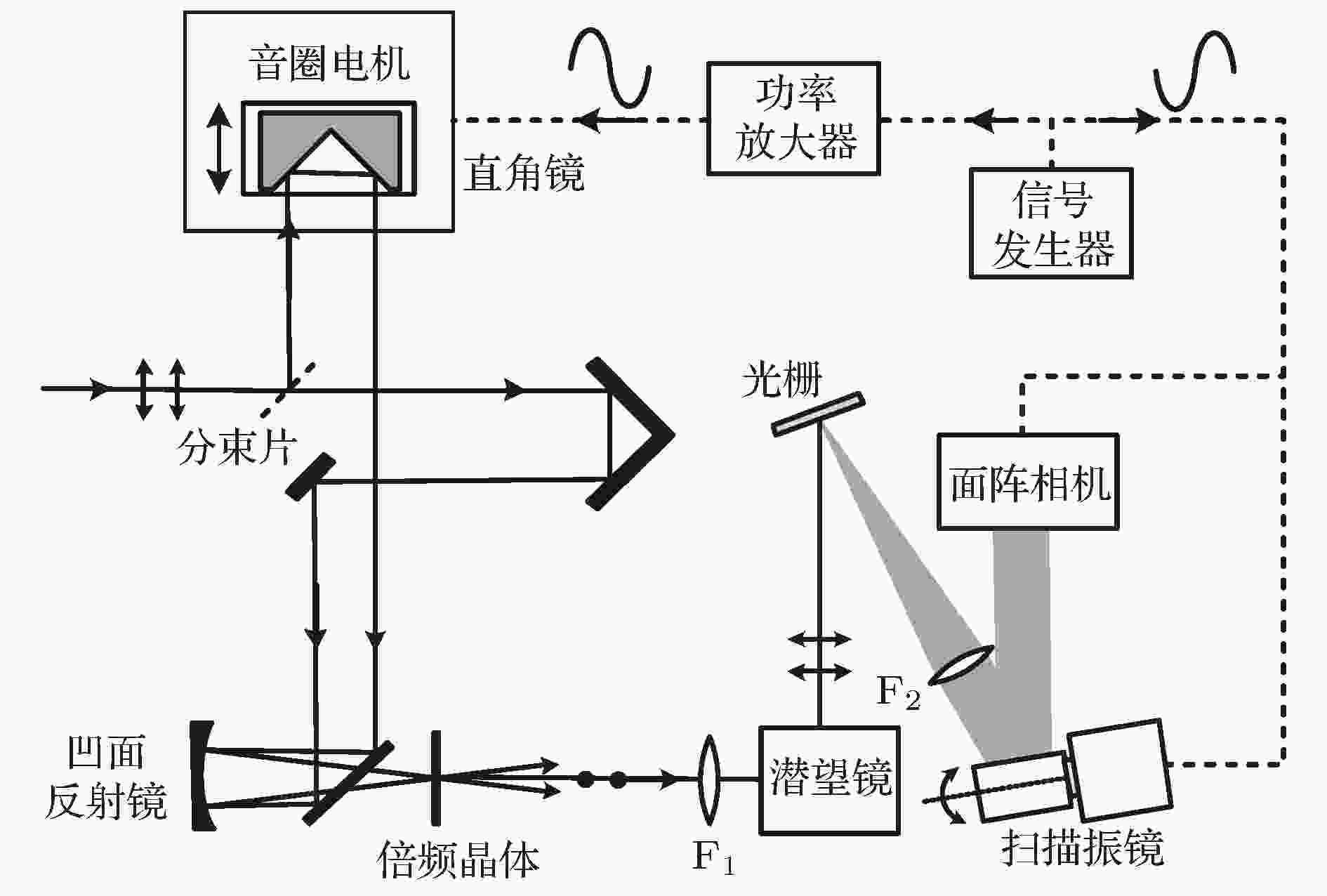
2019, 68 (11): 110601.
doi:10.7498/aps.68.20190034
Abstract +
Frequency-resolved optical gating (FROG) is now one of the main methods of characterizing the ultrashort laser pulses. There are mainly three SHG-FROG methods, i.e. the standard FROG, the single-shot FROG and GRENOUILLE, each of which has its own features and application areas. Although the standard SHG-FROG has balanced advantages in sensitivity, accuracy and applicability for various test pulses, its speed is much slower than the others’: it often takes a few seconds or even minutes to record the FROG trace, which is dependent on the size of FROG image. Nowadays continuous development of the technique of digital imaging brings to high resolution CCD/CMOS image cameras with tens of millions pixels and fast refreshing rate. Unfortunately the standard FROG cannot make use of these image cameras for the real-time measurement of ultrashort pulses. To solve this problem, in this paper a rapid-scanning FROG device based on the standard SHG-FROG is demonstrated, where sinusoidal waves from a signal generator synchronously drive a voice coil actuator and a galvo-scanner, so that the spectra of the autocorrelation at different delays are successively reflected onto an area camera. As long as the camera is triggered to shoot continuously, the entire FROG trace can be recorded quickly within 1 s. Furthermore, several guidelines for good performance with this device are provided, including the settings of the amplitude and frequency of the driving sinusoidal waves, the selections of the focuses of the collimating lens F1and the focusing lens F2, and the method of delay calibration. This device is suitable for the real-time measurement of ultrashort pulses with large chirps or complex structures where large-size FROG images need to be captured. In order to show the capability of this device, femtosecond pulses delivered directly from a home-made Kerr-lens mode-locked Ti: sapphire laser as well as the chirp pulses dispersed by a 200 mm-thick BK7 slab are measured. Two scan ranges are selected in order to achieve enough effective data points in the FROG traces of these two test pulses. Using standard procedure of pulse retrieval of FROG, the two pulses are reconstructed with pulse widths 58 fs and 492 fs, respectively. From the retrieved spectral phases of these test pulses, the GDD value of the BK7 slab can be deduced to be 8740 fs2, which is in good agreement with the theoretical value of 8815 fs2. Thus the experimental results confirm the accuracy and applicability of this FROG device.
ATOMIC AND MOLECULAR PHYSICS
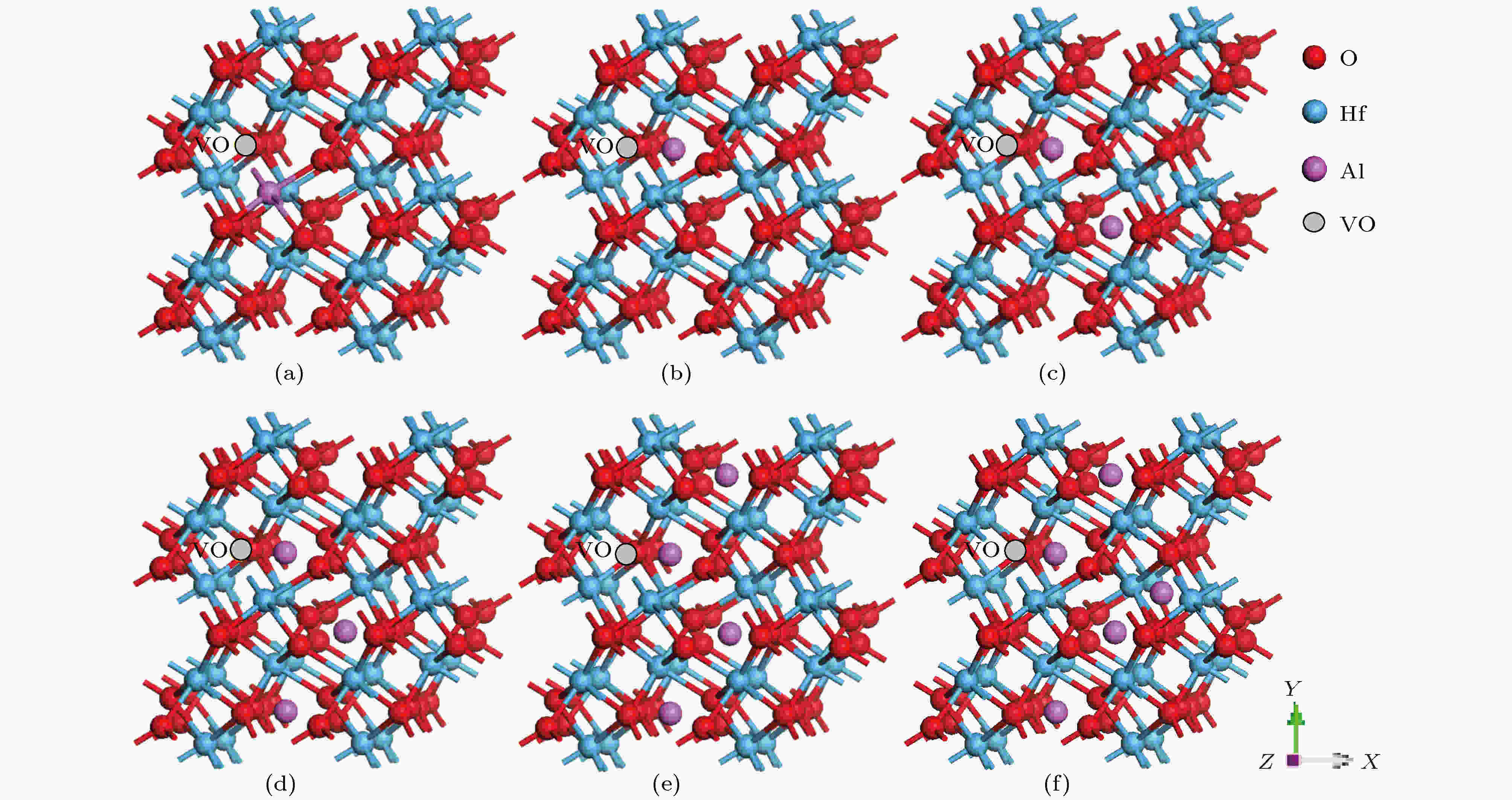
2019, 68 (11): 113101.
doi:10.7498/aps.68.20181995
Abstract +
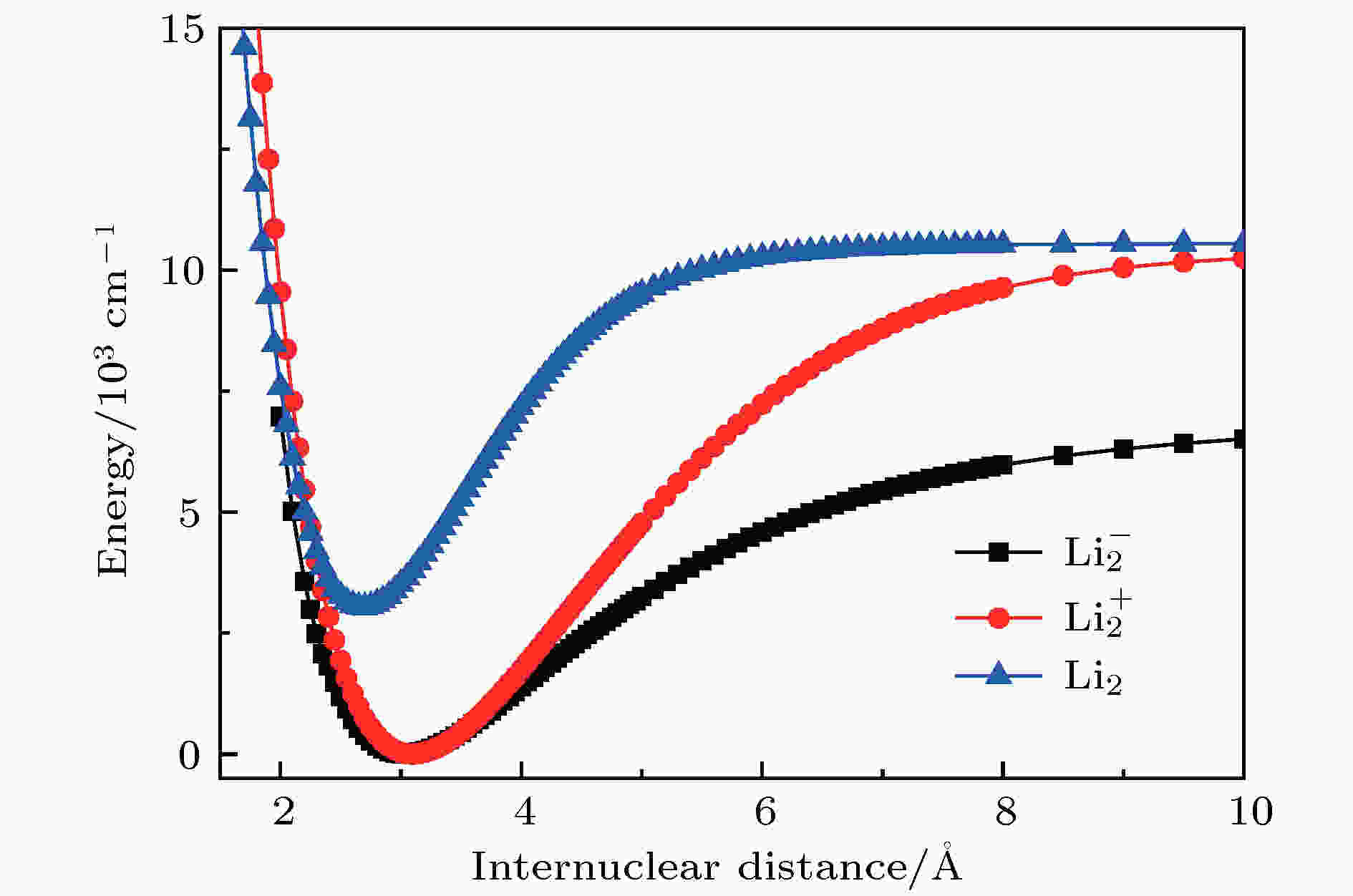
2019, 68 (11): 113102.
doi:10.7498/aps.68.20190359
Abstract +
The investigation of spectroscopic information is important for understanding the mechanisms of molecular photochemical and photophysical reactions. As a prototype to study the electronic structures and spectra of diatomic molecular systems, the vibration-rotational spectra of alkali dimer and its ions have aroused considerable research interest in the last two decades. Single-reference and multi-reference coupled cluster theory in combination with correlation consistent Gaussian basis set are adopted to study the ground-state potential energy curves of7Li2(0,± 1)molecular systems. The correlation effect and relativistic effect of all the electrons are taken into account in the calculation. And the spectroscopic constants, including the equilibrium internuclear distanceRe, the harmonic vibrational frequencyωe, the anharmonic constantωexe, the equilibrium rotational constantBe, and the dissociation energyDeof the molecular system and vibration-rotational energy level information of the ground states are obtained by solving the radial Schrödinger equations. The calculated spectroscopic constants of the neutral and positive ion system accord well with the experimental values; however for the negative ion system, the calculation of equilibrium internuclear distance needs further improving, and other spectroscopic constants are consistent well with the experimental values. The present computational results indicate that the ground state wave functions of neutral and positive ion systems have obvious single reference configuration characteristics, while the ground state of negative ion molecule system should be described with multireference configuration wave functions. The vibration-rotational energy levels of ground state with different theoretical methods are in good agreement with the experimental values. The vibrational-rotational energy levels and spectroscopic constants of neutral and positive ion systems are well reproduced, and some experimental information about spectrum is still lacking. Although the difference among the equilibrium internuclear distances for the ground state of the negative ion, obtained from different theoretical methods are still existent, the results of the vibrational level interval accord well with each other. This study provides useful information about spectrum for accurately investigating the electronic structures and spectra of the ground state of Li2molecular system and its two isotopic molecules, especially for the negative ion system with little information about spectrum.

2019, 68 (11): 113103.
doi:10.7498/aps.68.20182266
Abstract +
Using first-principles calculations, we investigate the stability and electronic properties of five isomers of two-dimensional (2D) GeSe monolayer under in-plane strain. Our calculated results show that the five isomers of GeSe monolayer are all stable. It is found that the α-GeSe has a direct band gap, while each of the β-GeSe, γ-GeSe, δ-GeSe and ε-GeSe possesses an indirect band gap. By applying compressive or tensile uniaxial and biaxial strain to the five GeSe isomers, the indirect-to-direct transition in band gap is found. In the α-GeSe, the changes from indirect-to-direct and semiconducting-to-metallic are both found under an applied strain. In the 2D β-GeSe and γ-GeSe, an adjustable range of indirect band gap under strain is found. Moreover, a direct band gap in the δ-GeSe is found separately under the biaxial compression strain ofσxy= –2% andσxy= –4%. By applying a tensile strain of 10% along the armchair direction in ε-GeSe, a transition from an indirect to direct band gap occurs. When the tensile strain is continuously increased to 20%, the band structure of ε-GeSe maintains direct character. This direct band gap can be tuned from 1.21 eV to 1.44 eV. When 10% tensile strain is applied along the biaxial direction, the transition in band gap from indirect-to-direct also occurs. Our results indicate that the direct band gap can be tuned from 0.61 eV to 1.19 eV when the tensile strain is increased from 10% to 19% in ε-GeSe.
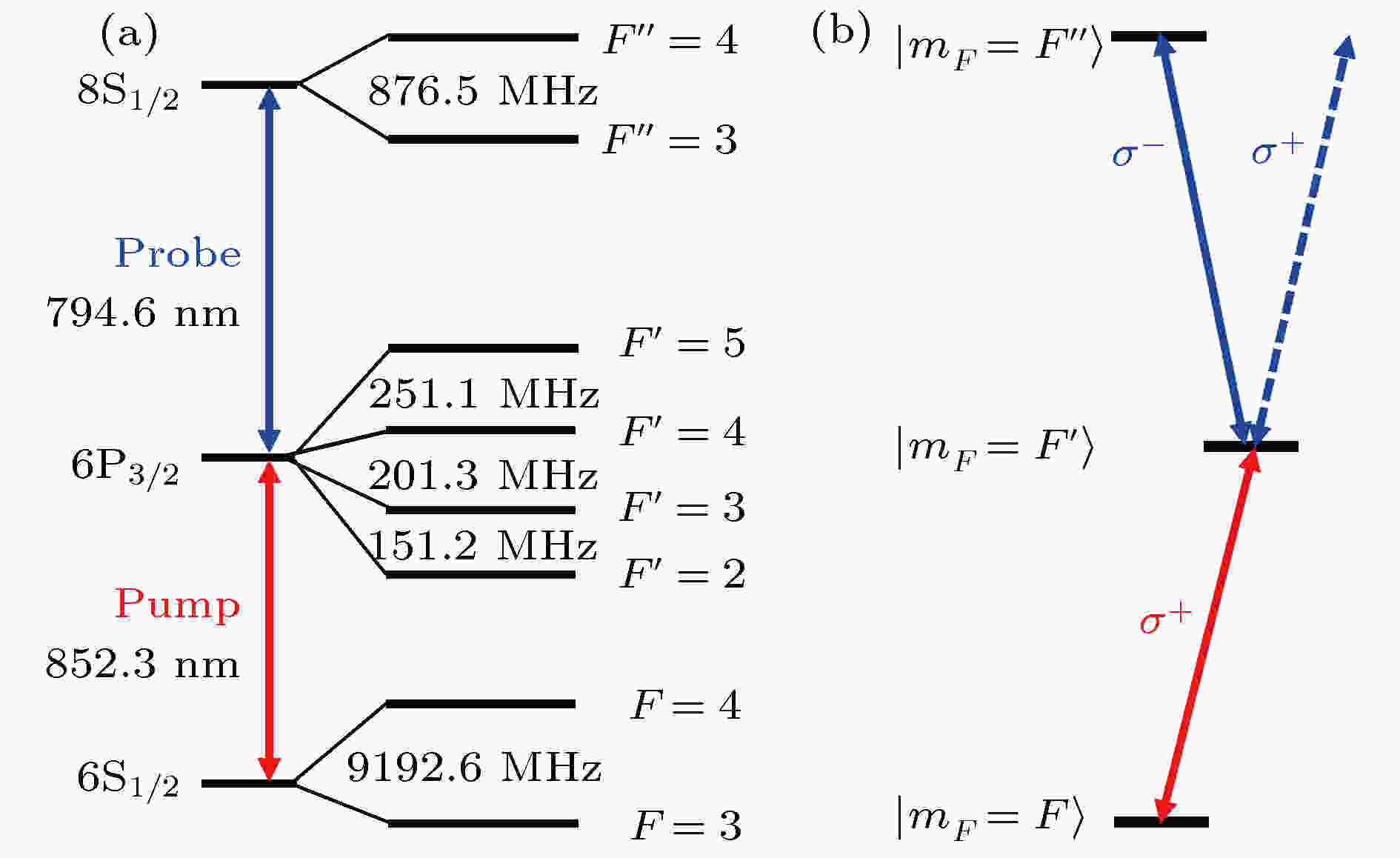
2019, 68 (11): 113201.
doi:10.7498/aps.68.20181872
Abstract +
Two-color polarization spectroscopy (TCPS) of cesium 6S1/2-6P3/2-8S1/2(852.3 nm + 794.6 nm) ladder-type system in a room-temperature vapor cell are investigated. The frequency of 852.3 nm laser used as a pump beam is locked on one of the hyperfine transitions between the ground state 6S1/2and excited state 6P3/2by the saturated absorption spectroscopy technique, which can populate some atoms on the 6P3/2excited state and induce anisotropy in the atomic medium. The frequency of 794.6 nm laser serving as a probe beam is scanned across the whole 6P3/2→8S1/2transition to ascertain this anisotropy, and thus the TCPS is obtained. In experiment, we measure and analyse the influence of frequency detuning of 852.3 nm pump laser on TCPS, and especially reveal that some of hyperfine energy levels of intermediate excited state 6P3/2, which has no direct interaction with the 852.3 nm pump laser, are also populated by a small fraction of atoms with a specific speed in the direction of pump laser beam due to Doppler effect, so they also have contribution to the TCPS when the 794.6 nm probe laser is scanned to the resonance transition line between the 6P3/2and 8S1/2states after the Doppler frequency shift has been considered. In addition, we prove that the atomic coherence like electromagnetically induced transparency effect obviously results in a narrower line width of TCPS in the case of counter-propagating experimental configuration than that in the case of pump beam co-propagating with the probe beam in the Cs vapor cell. Finally, we apply the TCPS with dispersive shaped feature to frequency stabilization with no modulation, and the frequency fluctuations of 794.6 nm laser are ~0.5 MHz and ~9.2 MHz for the frequency-locking and free running in ~225 s, respectively. The above research work is expected to play a role in precisely measuring the atomic energy level structure and its related hyperfine structure constant (magnetic dipole and electric quadrupole coupling constants), and also in stabilizing the laser frequency to the excited state transition especially for the optical fiber communication, two-color laser cooling/trapping neutral atoms, optical filter, etc.
ELECTROMAGNETISM, OPTICS, ACOUSTICS, HEAT TRANSFER, CLASSICAL MECHANICS, AND FLUID DYNAMICS
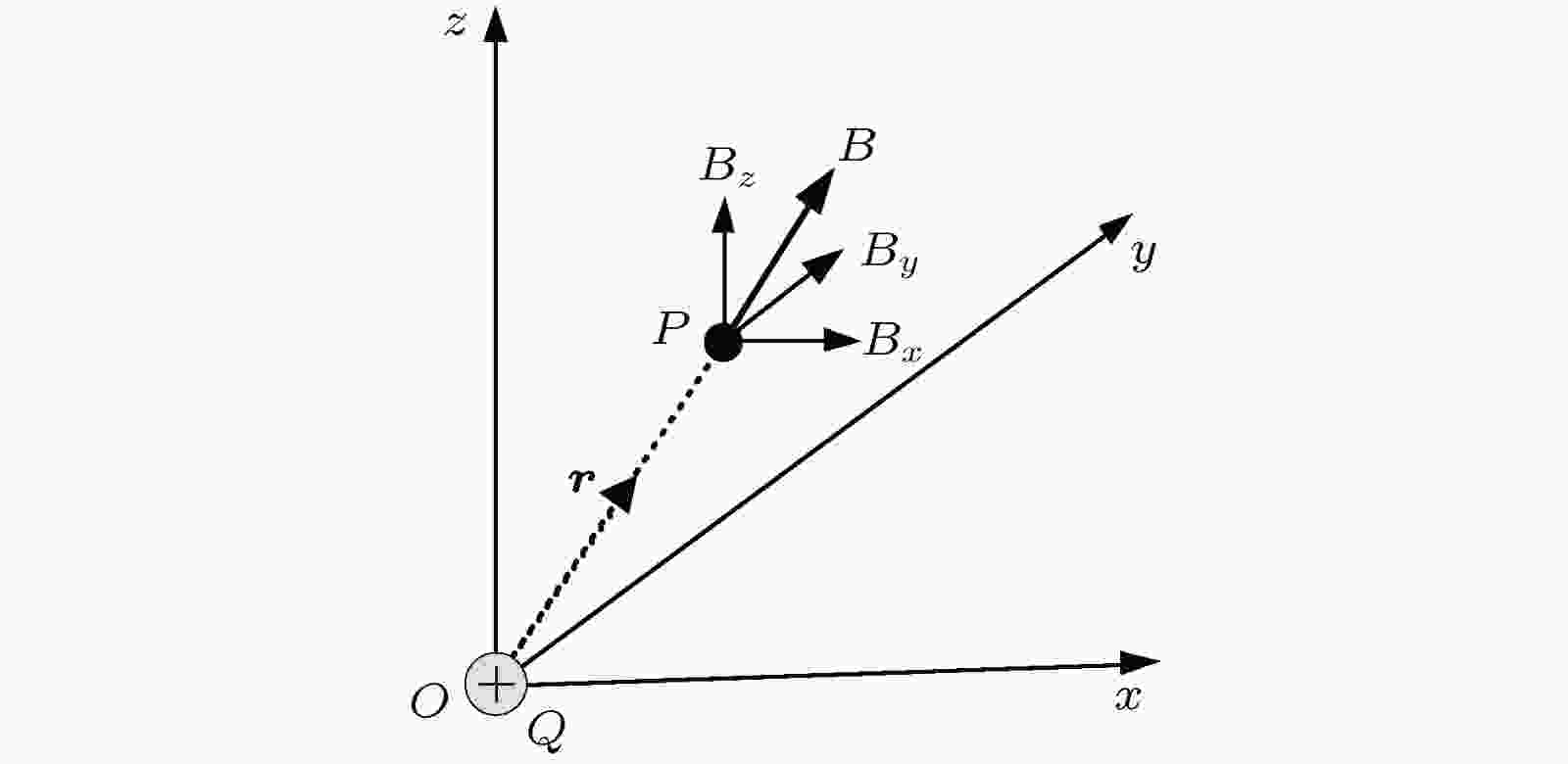
2019, 68 (11): 114101.
doi:10.7498/aps.68.20190201
Abstract +
Aiming at the problems of low accuracy and low adaptability of the existing ship magnetic field inversion modeling methods with equivalent sources, a new method of inversion modeling of magnetic monopole array of ship magnetic fields is proposed. Three-dimensional ship magnetic monopole array is arranged according to the ship ferromagnetic structure, and the inversion prediction model of ship magnetic fields is established by regularization technology. Three typical forms of magnetic monopole arrays are established: rectangular magnetic monopole array on the horizontal surface of the draft line, cuboid magnetic monopole array enclosing the ship hull, three-dimensional ship magnetic monopole array distributed according to the ship’s ferromagnetic structure. The theoretical analysis shows that the three-dimensional ship magnetic monopole array reduces the blindness of the equivalent magnetic source setting, and the obtained equivalent magnetic source is highly consistent with the real magnetic source, which can reproduce the complete magnetic field information of the ship to a greater extent. The magnetic field of a typical virtual ship is applied to the validation test. The results show that the proposed three-dimensional ship magnetic monopole array has higher precision and adaptability than the rectangular or cuboid magnetic monopole array. In particular, the proposed three-dimensional ship magnetic monopole array can realize the mutual conversion between the near and far magnetic fields, and between the magnetic fields above and below the ship. The proposed three-dimensional ship magnetic monopole array model has the unique advantages of small complexity, simple modeling and flexible layout, and it provides an alternative method for the high-precision data processing and explanation to the inversion modeling of ship magnetic fields, ship magnetic field positioning, et al.
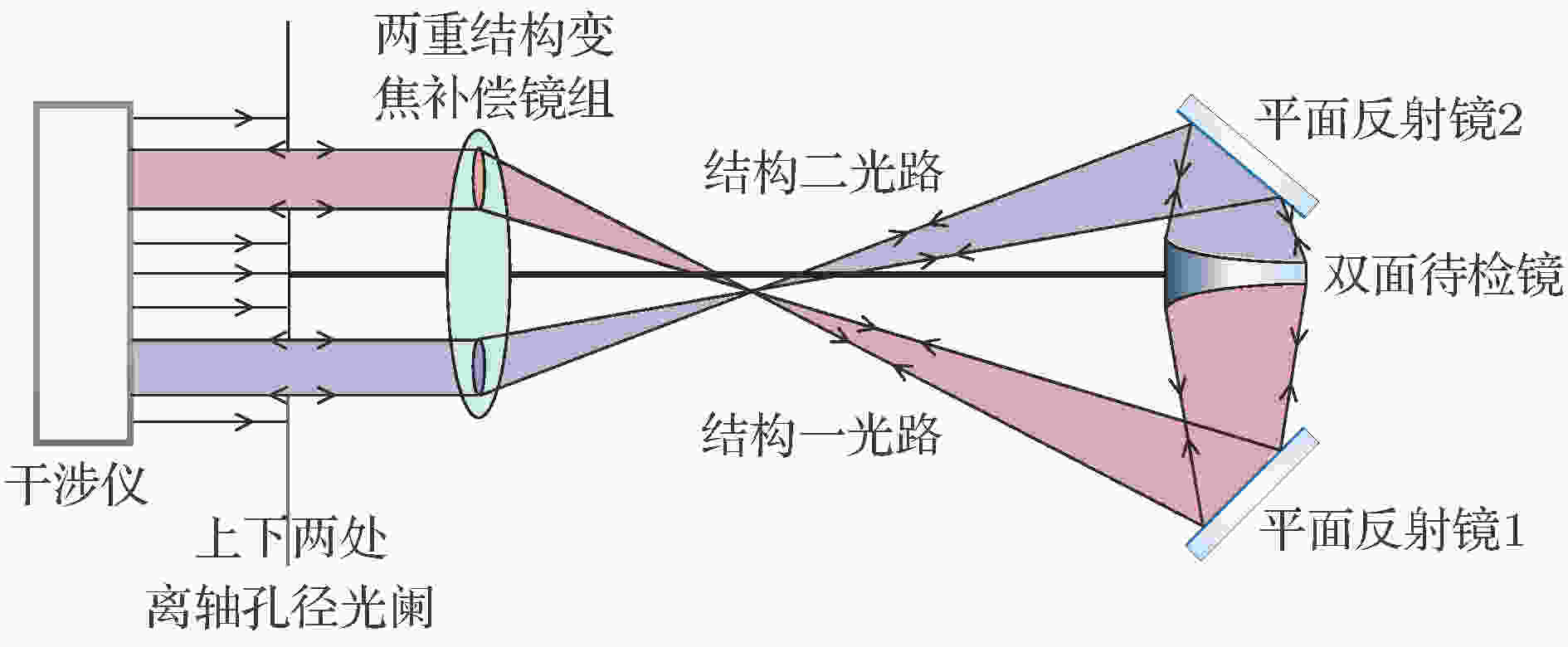
2019, 68 (11): 114201.
doi:10.7498/aps.68.20182253
Abstract +
With the development of multispectral common-aperture high-precision detection technology, the asymmetric double-sided off-axis aspheric mirror is playing an increasingly important role in characterizing the correcting phase difference, increasing the relative caliber of system, expanding the view angle of field, simplifying system structure, and reducing weight and volume. But high-precision detection is a key step restricting the applications of these mirrors. At present, the compensation method of the interference test is the most effective mean of off-axis aspheric surface detection which has a simple structure, large compensation range, small number of components and is easy to control. However for the detection of asymmetric double-sided off-axis aspheric mirrors, two sets of alone compensators are still used, in which the efficiency is low and the switching compensator will reduce the accuracy of detection. Aiming at this problem, in this paper we propose a zoom null compensation method which is based on the Offner refracting compensation method. In this method, the off-axis aperture stop causes the light to be off-axis and split, the common lens group is moved to zoom, and the mirror folds the light path. There are two off-axis apertures are provided for off-axis and splitting, four lenses which form three lens groups are used to move positions for zooming, two mirrors are used to fold light. An optical design software is used to simulate the experiment, and implements the design for the high-precision detection of optical path for the asymmetric double-sided off-axis aspherical mirror by using this set of null compensation method. The simulation result shows that the theoretical residual wave aberration increases up to 0.0003λ root-mean-square (RMS) and 0.0001λ RMS with the designed system compensation, which meet the requirement for detection. At the same time, the tolerance analysis is carried out according to the design result, the actual residual wave aberrations within the existing tolerance range are 0.0326λ RMS and 0.0316λ RMS, which meet the requirements for manufacturing and assembly. The present work provides a new idea for the high-precision detection of asymmetric double-sided off-axis aspheric mirror. At the same time, the quality of the detected beam in this paper is achieved under ideal conditions, and the quality of beam will be considered in the next research work.
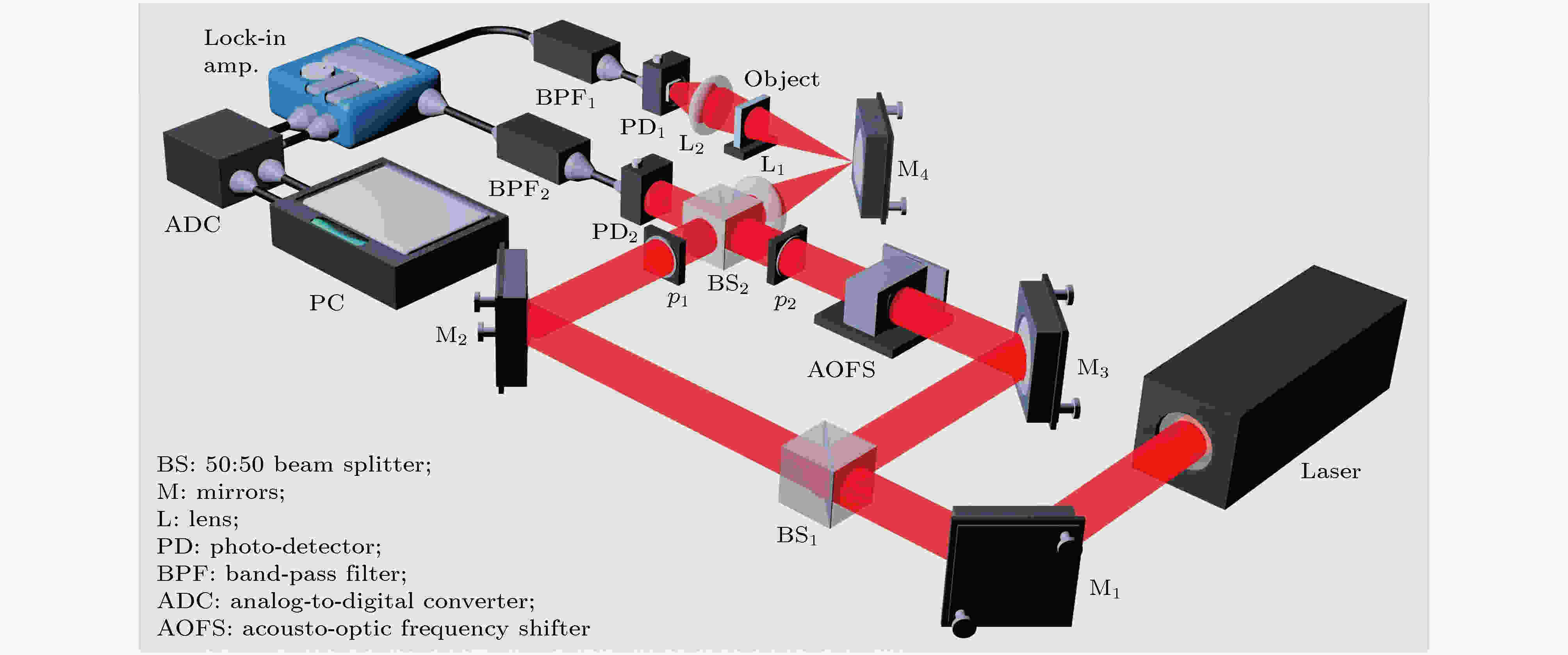
2019, 68 (11): 114202.
doi:10.7498/aps.68.20190162
Abstract +
In this paper, the function of parallel encrypting multiple images and reproducing arbitrary layers of images is realized by improving the double pupil function in optical scanning holography. In an optical scanning holography (OSH) system, a dual-pupil heterodyne incoherent image processing technique is used to record holographic images. By adjusting the two pupil functions in the optical system, the interference fringes can be modified to achieve different imaging effects. In this paper, the ring pupil and random phase plate are used to act as two pupil functions to interfere to form a ring random phase plate, and thus realizing the fast scanning of multi-layer images. Then the multi-layer images can be quickly encrypted by one imaging technique. The scanned signals are quickly collected by photoelectric detectors, and they synthesize encrypted holograms by computer. By using the digital holography to decrypt the holograms, the precise reproduction of any layer image can be achieved. The OSH system with random phase pupil is strongly dependent on the longitudinal position of the system in digital reconstruction. The defocusing noise can be converted into random noise and the effect of defocusing layer on imaging can be effectively suppressed. However, in practice, it is necessary to average multiple images to achieve better imaging effect, and the accuracy of random phase plate is required. In this paper, most of the random noise can be filtered with the aid of ring pupil, and all the information about multi-layer graphics can be recorded and reconstructed by one scan. In the process of reconstruction, the influence of defocusing image can be effectively eliminated, and the decryption of any layer image can be realized. This method collects encrypted image by photoelectric detector, and does not need complex algorithm reconstruction nor phase iteration, which greatly reduces the time expended in the encryption process. In the process of encryption, the key space of the system is increased, and the encrypted image obtained has high security. In this paper, correlation coefficient is used to evaluate the encryption effect of this method, and the effectiveness and security of this method are verified by simulation experiments. For cutting resistance, when 75% of the information is lost, the correlation coefficient can still reach more than 0.5. For the sensitivity of information, the integrity of decrypted image will be seriously damaged when the wavelength and distance shift very little. For the anti-noise ability, under the influence of Gauss noise and salt and pepper noise, the correlation coefficient and image recognition degree are high. This method is very time-saving, and the result of encryption has high security, high sensitivity, strong ability to resist clipping and noise.
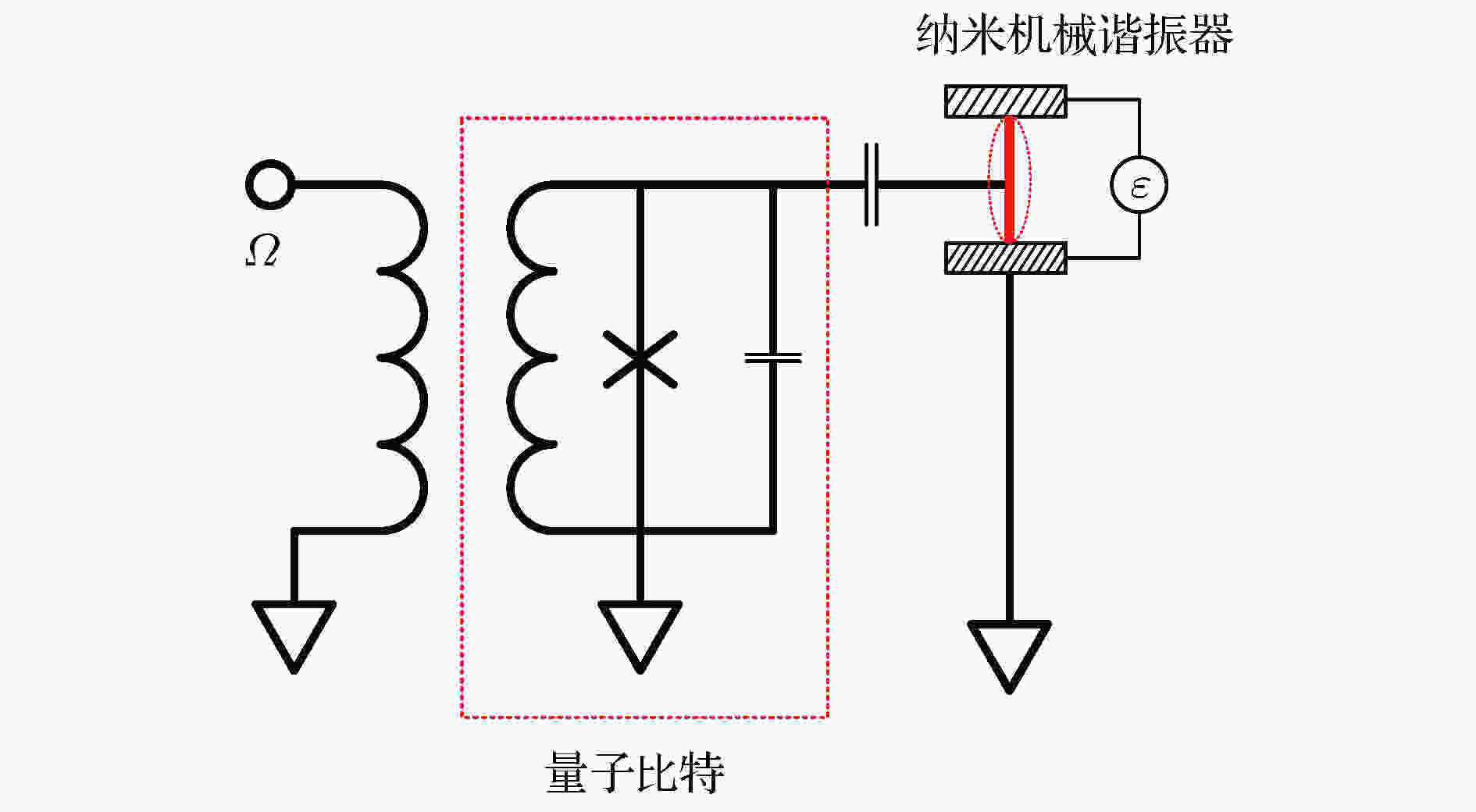
2019, 68 (11): 114203.
doi:10.7498/aps.68.20182263
Abstract +
Nanomechanical resonator has important applications in the field of high-precision detection because it has a high-Qfactor, high vibration frequency, small size, and other excellent characteristics. Superconducting qubit has very large magnetic dipole moments, so it can be easily combined with nanomechanical resonator. Furthermore, the system parameters including frequency and coupling strength can be designed according to requirements beforehand, which makes a superconducting qubit an ideal artificial atom. Compared with natural atom, superconducting qubit has abundant energy levels. For these reasons, nanomechanical system has aroused wide interest in the engineering, electron, physical and other fields of science and technology. According to the recent research, a new approach to the zero eigenvalues of non-Hermitian Hamiltonian is applied to the optomechanical system. It was found that the scheme is superior to conventional photon blockade (CPB) and unconventional photon blockade (UPB) in the cavity quantum electrodynamics (QED) system. So we propose a scheme to induce phonon blockade in order to explore a new avenue to the research about phonon blockades in the quantum open system. We study the phonon blockade in an optomechanical system that a qubit is coupled with nanomechanical resonator (NAMR) driven by two external weakly driving fields respectively in this way. In this paper, the Hamiltonian of such a system can be treated by the non-Hermitian Hamiltonian and it can be described in the form of matrix. Then the phenomenon of phonon blockade occurs when all the eigenvalues in the form of matrix are equal to zero. It is found that strong phonon antibunching can be triggered in both strong and weak nonlinearity when we use the method which has been already used in a gain optical cavity system. The distinct result reflects the advantage of our approach which possesses some outstanding characters between the ordinary methods (conventional phonon blockade and unconventional phonon blockade). In addition, the effect of our avenue on phonon blockade is analyzed and also the distinction between the conventional phonon blockade (CPNB) and unconventional phonon blockade (UPNB) is compared with each other in detail. By analytical calculation, the optimal conditions are given and the underlying physical mechanism is explained. In the comparison between CPNB and UPNB, we show the superiority of our scheme through some graphs. Finally, we describe briefly the measurements of phonon blockade in the NAMR-qubit system via a superconducting cavity. The proposal may provide a theoretical way to guide the manufacture of phonon devices in the future. The results obtained here may have a great significance and application in the field of quantum information processing and precision measurement.
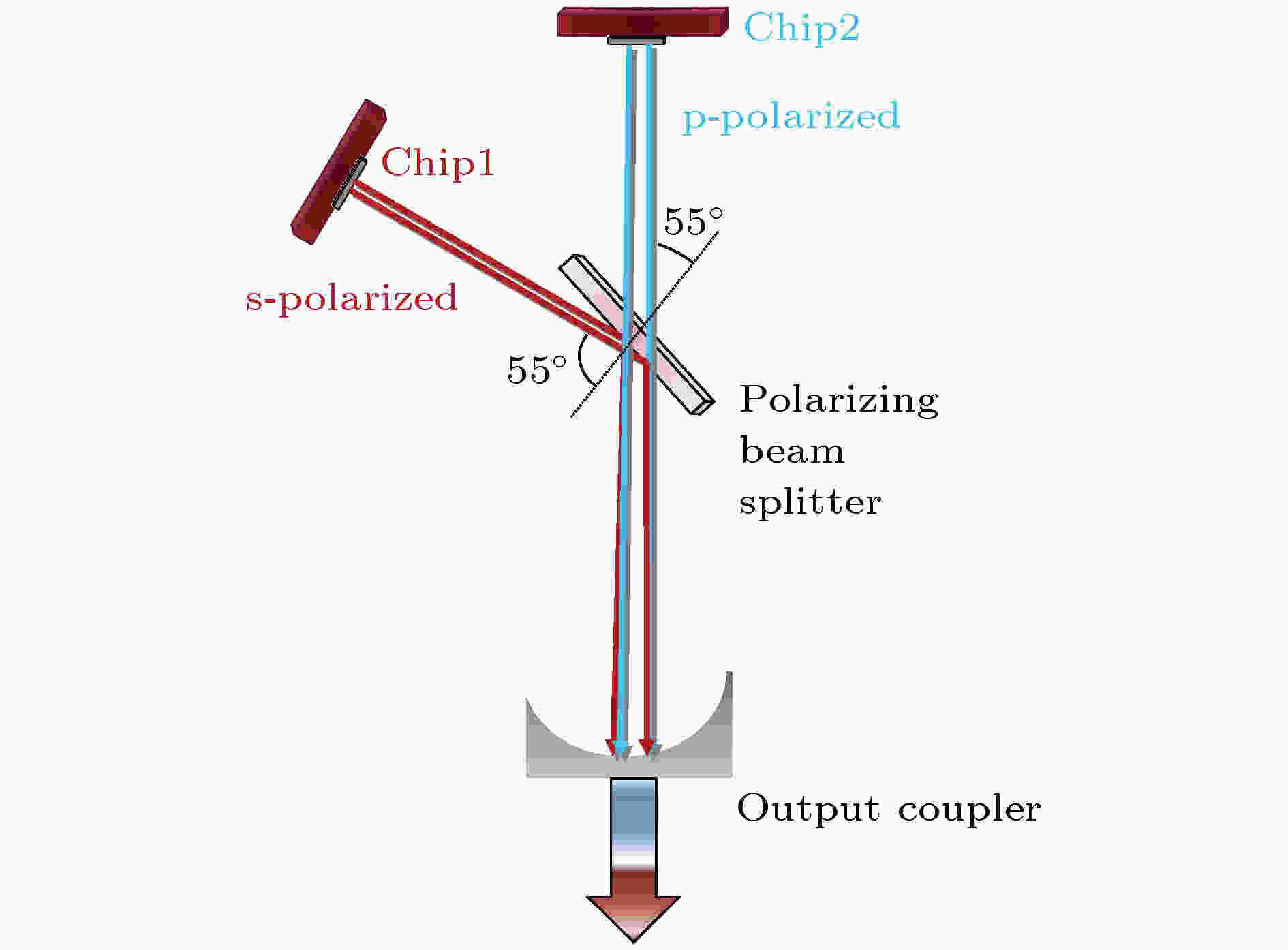
2019, 68 (11): 114204.
doi:10.7498/aps.68.20182261
Abstract +
Dual-wavelength laser sources have important applications in the interferometry and the nonlinear-frequency-conversion generated mid-infrared or terahertz-band coherent radiation. Vertical-external-cavity surface-emitting lasers own outstanding advantages such as high output power, good beam quality and flexible emission wavelength, which make them very suitable for dual-wavelength running. In this paper, we employ a collinear Y-type cavity to produce a dual-wavelength laser. There are two semiconductor gain chips in the resonant cavity, one has an active region of In0.185Ga0.815As/GaAs strained multiple quantum wells and a designed wavelength of 960 nm, and the other has an active region of In0.26Ga0.74As/GaAsP0.02strained multiple quantum wells and a target wavelength of 1080 nm. The peak wavelength of the photoluminescence of chip 1 is 950 nm, which is 10 nm shorter than the designed wavelength under weak pump, and the peak wavelength of the photoluminescence of chip 2 is 1094 nm, which is 14 nm longer than the target wavelength under low pump. When the pump power is increased, the peak wavelengths of the photoluminescence of two gain chips are both red-shifted. The oscillating laser wavelengths are centered at 953 nm and 1100 nm, the corresponding full width at half maximum (FWHM) values of the laser spectra are 1.1 nm and 2.7 nm, respectively. The wavelength spacing of the dual-wavelength is 147 nm, and the related mid-infrared coherent radiation is about 7.1 μm on the assumption that the dual-wavelength laser is used for difference frequency generation. When the absorbed pump power of each gain chip is 5.8 W, the total output power of the dual-wavelength laser reaches 293 mW at room temperature.
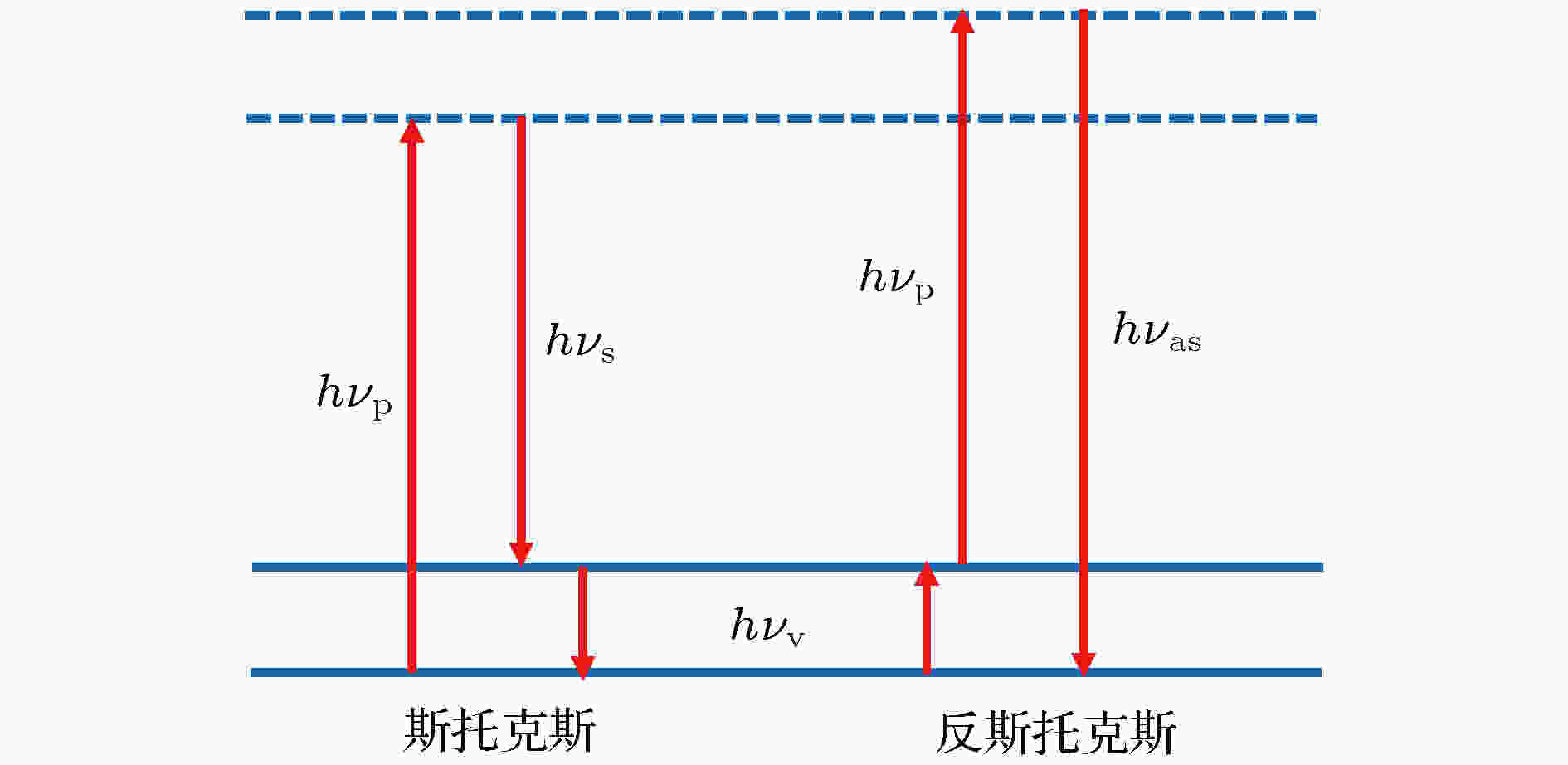
2019, 68 (11): 114205.
doi:10.7498/aps.68.20190178
Abstract +
In order to improve the output power and processing quality in industrial applications, it is important to optimize the output characteristics of the high-power fiber lasers. The slope efficiency, backward leaking power and stimulated Raman scattering are key issues in high-power fiber laser design. The parameters matching the fiber gratings, which are the critical components, have a direct influence on the whole fiber laser system. In this paper, the parameters matching the fiber gratings in fiber lasers are investigated. Firstly, the origin of slope efficiency, backward leaking power and stimulated Raman scattering are analyzed in theory. Then the influences on output characteristics of fiber lasers comprised of the output coupler gratings, which have different bandwidths and reflectivities, are experimentally studied. Finally, the optimized parameters and matching principle of fiber gratings in high-power fiber laser are obtained , thus providing an alternative method to improve the output characteristics of high-power continuous wave fiber laser.
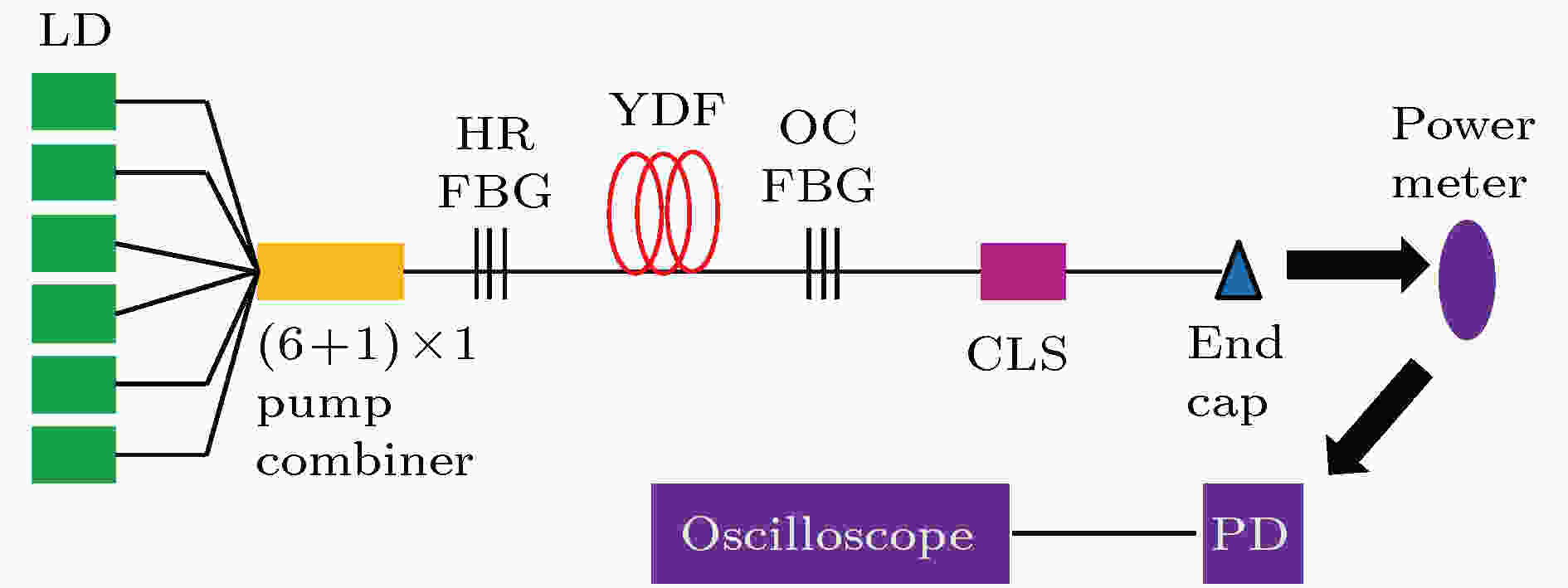
2019, 68 (11): 114206.
doi:10.7498/aps.68.20182257
Abstract +
The phenomenon mode instability is the most limiting factor for further scaling the output power and beam quality in high power fiber lasers. Thus, it is meaningful and necessary to study the influencing factor of mode instability and finally find the approaches to mitigating its influence. Theoretical calculations reveal that the fiber V-parameter has a negative effect on fiber amplifier mode instability threshold. Nevertheless, the influence of fiber core numerical aperture (NA) on fiber oscillator mode instability threshold has rarely been investigated compared with that on the fiber amplifier. In this paper, we build a high-power all-fiber laser oscillator pumped by 976nm laser diodes and measure its laser efficiency and mode instability threshold of 20/400 step-index ytterbium doped fiber with different fiber coreNA. Experimental result reveals that at the same 976 nm pump power, the fiber with relatively low coreNA(~0.059) has a higher mode instability threshold power than that with relatively high coreNA(~0.064), and that even a higher coreNA(~0.064) fiber has a higher laser efficiency than lower coreNA(~0.059) fiber. The fact shows that the fiber coreNAhas a significant influence on mode instability threshold, and a relatively high coreNAresults in a lower mode instability threshold. Also, numerical simulations explain the reason why the fiber coreNAhas a negative effect on mode instability threshold in fiber oscillator. First of all, the higher fiber coreNAwill support more propagating modes in fiber, and the lower fiber coreNAwill result in higher order mode (HOM) content leaking into fiber cladding and the overlap of HOM content and gain area is reduced, thus the gain of HOM is relatively reduced. Also, the bending loss of HOM is very sensitive to fiber coreNAvariation, and the increase of fiber coreNAwill reduce the bending loss of HOM dramatically. In conclusion, the fiber coreNAhas a significant negative effect on fiber oscillator mode instability threshold, and numerical simulationscan explain the physical origin of the negative effect of fiber coreNAon laser oscillator mode instability threshold. Thus, for the mode instability mitigation in high power laser oscillator, optimizing theNAof active fiber conduces to the increase of mode instability threshold, which is helpful and necessary for further scaling the output power and beam quality.

2019, 68 (11): 114207.
doi:10.7498/aps.68.20182129
Abstract +
In recent years, the transmission capacity of wavelength division multiplexing (WDM) communication systems has gradually approached to the nonlinear Shannon limit. To meet the increasing demand for communication capacity, space division multiplexing (SDM) has become one of the most concerned technologies. In this paper, the four-wave mixing process (FWM) in fibers is considered from the frequency domain to the mode division multiplexing (MDM) spatial domain under pump depletion and the exact analytical solution to the FWM coupled-mode equations in the space-frequency domain is in detail deduced. The analytical method is verified by numerically calculating the amplitude and phase evolution of the idler wave in non-degenerate four-wave mixing. We discuss three new applications of the analytical solution as follows. 1) Using the phase matching condition we select the terms in the multi-wave coupling equation, and only retain the coupling term that plays a major role. According to the analytical solution in this paper, the phase matching percentage parameter is introduced to determine the FWM coupling terms necessary for multi-wave coupling equations, thus simplifying the multi-wave coupling problem in the study. 2) Combining the analytical solution with the numerical calculation results, we find the initial phase relationship between the output idler and the input guided wave for phase-insensitive FWM, and we provide the analytical expression for a theoretical basis to efficiently design the FWM-based phase arithmetic devices in parallel operating at WDM and MDM systems. 3) We propose a nonlinear compensation algorithm based on analytical solution, which can be used in the few-mode transmission system. The algorithm can fast evaluate or compensate for the fiber nonlinearity by taking into account the pump depletion of the FWM effect. Compared with the traditional digital back propagation (DBP) algorithm, our algorithm has the advantage of lower complexity.

EDITOR'S SUGGESTION
2019, 68 (11): 114208.
doi:10.7498/aps.68.20182247
Abstract +
In the optical system of spaceborne laser altimeter, dielectric mirror is an indispensable optical film element. Its surface shape quality directly affects the resolution and accuracy of distance measurement of the detection system. It is pressing and necessary to carry out research on the surface shape control technology of dielectric mirror to eliminate or reduce the effect of film stress on surface shape. The Ta2O5/SiO2multilayer reflective coatings are deposited on quartz substrates by using the ion beam assisted electron beam evaporation (IBE), and then annealed in air in a temperature range from 200 to 600 ℃. The effect of annealing temperature on the structure, optical and stress properties of Ta2O5/SiO2multilayer reflective coatings are systemically investigated by using x-ray diffraction, atomic force microscope, spectrophotometer and laser interferometer. The results show that all the Ta2O5/SiO2multilayer reflective coatings, after being annealed, are amorphous in structure. The annealing temperature has a great influence on the surface roughness of reflective coating. With the increase of annealing temperature, the surface roughness of reflective coating first decreases and then gradually increases, but is still smaller than that of as-deposited sample. After being annealed, the reflectance spectrum of reflective coating shifts slightly toward the long-wave direction, and the reflectivity increases a little. When being annealed at 500-600 ℃, the compressive stress of reflective coating could be transformed into tensile stress, and the surface is changed from convex to concave shape. It can be concluded that annealing at an appropriate temperature can effectively release residual stress of Ta2O5/SiO2multilayer reflective coating and eliminate the deformation of substrate caused by film stress, and thus improving the surface shape quality of dielectric mirror., After being annealed, the reflective coating still possesses the stable structure and spectral properties, so that dielectric mirror can meet the application requirements of spaceborne laser altimeter. In this paper, the experimental results are of great significance for applying the annealing technology to the surface shape control technology of dielectric mirrors.

2019, 68 (11): 114209.
doi:10.7498/aps.68.20190381
Abstract +
In an optical fiber communication system, vortex beams have aroused great interest in the last several decades. Vortex beams possess many intriguing properties. For example, they have the ability to carry orbital angular momentum (OAM) which is mutually orthogonal. The OAM is a fundamental physical quantity of light which can be used as information carriers for transmission channel of optical fiber. Combined with the existing multiplexing techniques such as wavelength division multiplexing technique, advanced multilevel amplitude modulation formats, etc., the vortex beams provide an alternative to the increase of the transmission capacity and spectral efficiency of the optical fiber transmission system. Recently, long-length transmission of vortex-beam in optical fiber has been realized and there have also occurred some new designs of optical fiber on vortex beams, such as air-core ring shaped fiber, graded index vortex fiber, multi-ring fiber, and supermode fiber. Photonic crystal fiber (PCF) is flexible in design. Therefore, it is easy to regulate the transmission performance of PCF by adjusting the radius and the pitch of the air holes and so on. In this paper, we propose a newly designed sixfold photonic quasi-crystal fiber (SPQCF) to transmit vortex beams stably. Transmission characteristics of this newly designed fiber are simulated and calculated by using COMSOL multiphysics software. When the wavelength of the incident light is 1550 nm, the effective index difference between the vortex modes in a group is more than 10–4which is large enough to preclude the LP modes from being formed, and to transmit 7 vector modes (10 OAM modes). Changing the radius and pitch of the air holes, we can regulate the dispersion characteristic and confinement loss of the SPQCF flexibly. At 1550 nm, the confinement loss of the SPQCF maintains 10–8−10–7which is low enough to confine the vortex beams in the fiber core. When the incident light wavelength of HE21ranges from 1500 nm to 1800 nm (r0= 1.9 μm), the dispersion coefficient of the SPQCF is between 63.51−65.42 ps·nm–1·km–1which tends to be flat. By changingr0, the flat trend is adjusted to different wavelength range. This dispersion characteristic possesses great potential for the transmission of optical solitons. The effective mode area (HE21) is about 40 μm2and the nonlinear coefficient (HE21) is maintained on the order of 10–3between 1500−1600 nm. These features suppress the generation of nonlinear effect in the fiber and benefit the transmission of vortex beams. The stable transmission distance is longer than 1 km. In summary, we design a new type of PCF featuring quasi-crystal structure which has a ring shaped fiber core and supports the transmission of vortex beams stably.
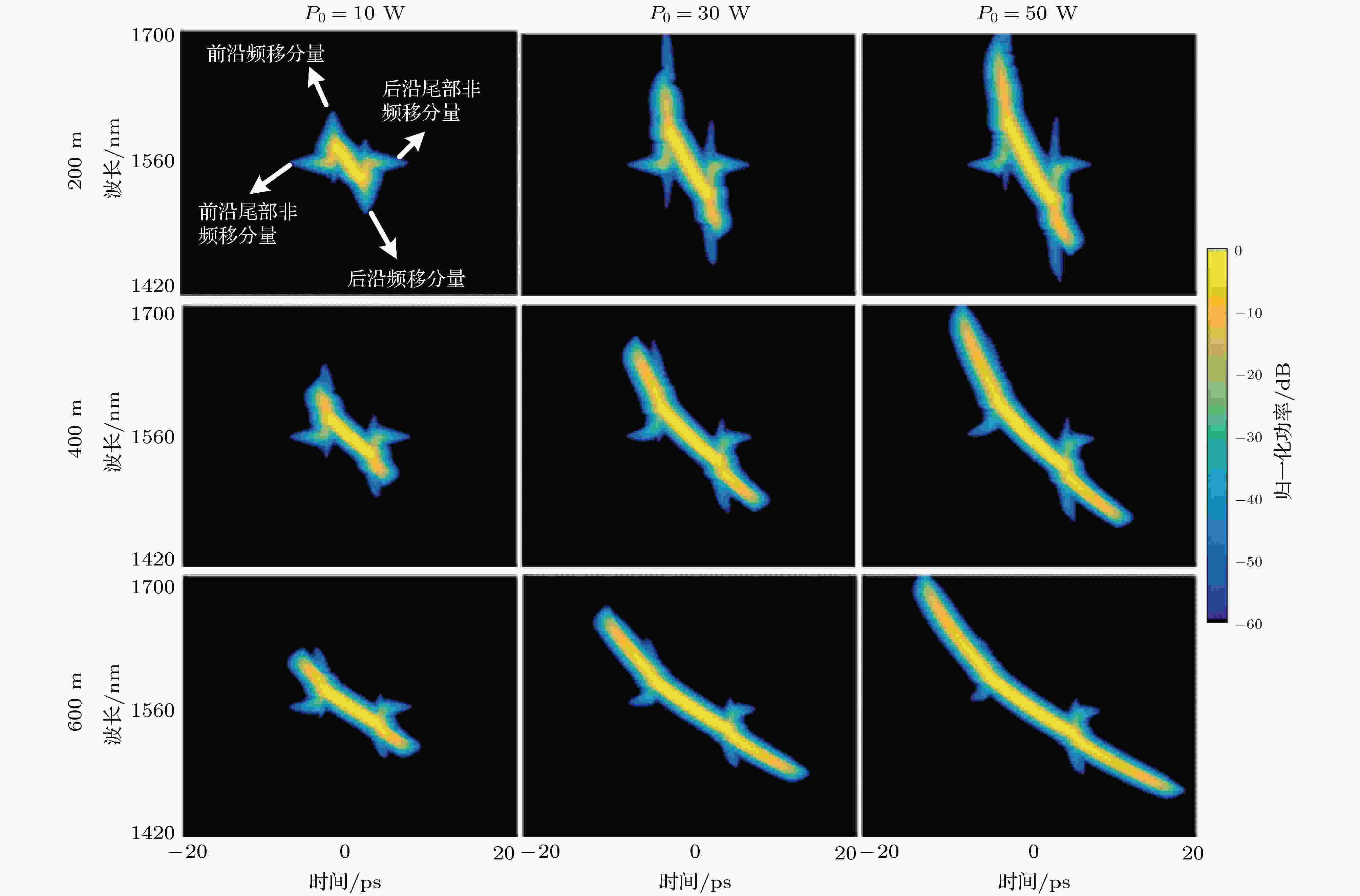
2019, 68 (11): 114210.
doi:10.7498/aps.68.20190111
Abstract +
Supercontinuum generated in normal dispersion region of highly nonlinear fiber (HNLF) is widely used in signal processing and communication benefiting from its good flatness and high coherence. Because of the normal dispersion, optical wave breaking (OWB) occurs when non-frequency shift components and frequency shift components caused by self-phase modulation (SPM) overlap in time domain, and ends when non-frequency shift components disappear. The evolution of non-frequency shift components at the front and rear edge of optical pulse play an essential role in the supercontinuum generation process. In this paper, the evolution of non-frequency shift components in normal dispersion region is numerically calculated and analyzed based on generalized nonlinear Schrödinger equation. The results demonstrate that non-frequency shift components shrink gradually as the pulse propagates in the normal dispersion region. Cross-phase modulation (XPM) and stimulated Raman scattering (SRS) play a major role in this process, while the third-order dispersion imposes little effect on it. Because of XPM, non-frequency shift components at the front and rear edge shrink gradually, and keep red shifting and blue-shifting respectively. The influence of XPM on the non-frequency shift components at both edges is symmetrical. However, the influence of SRS on the evolution of non-frequency-shift components at both edges is asymmetric. At the front edge, SRS transfers the energy from non-frequency shift component to frequency shift component, which is opposite to that at the rear edge. At the front edge, SRS accelerates the shrinking process of the non-frequency shift component, while it slows down the shrinking process at the rear edge. And this asymmetric effect is more obvious when the peak power of the pulse is higher and SRS is more efficient. The evolution of the non-frequency shift components of chirped pulses propagating in the normal dispersion region is studied. Comparing with the unchirped pulse, the non-frequency shift components at the front and rear edge of the chirped pulse have different wavelengths. For the negative chirped pulse, the wavelength spacing between the overlapped frequency-shift components and non-frequency shift components is larger, which is easier to satisfy the SRS gain range. Therefore, the evolution of non-frequency-shift components at the front and rear edge of the negative chirped pulse are more asymmetric due to the higher SRS efficiency. For positive chirped pulses, the wavelength spacing between the overlapped components is difficult to satisfy the SRS gain range. The evolution of non-frequency-shift components in the positive chirped pulses is more symmetrical due to the lower SRS efficiency.
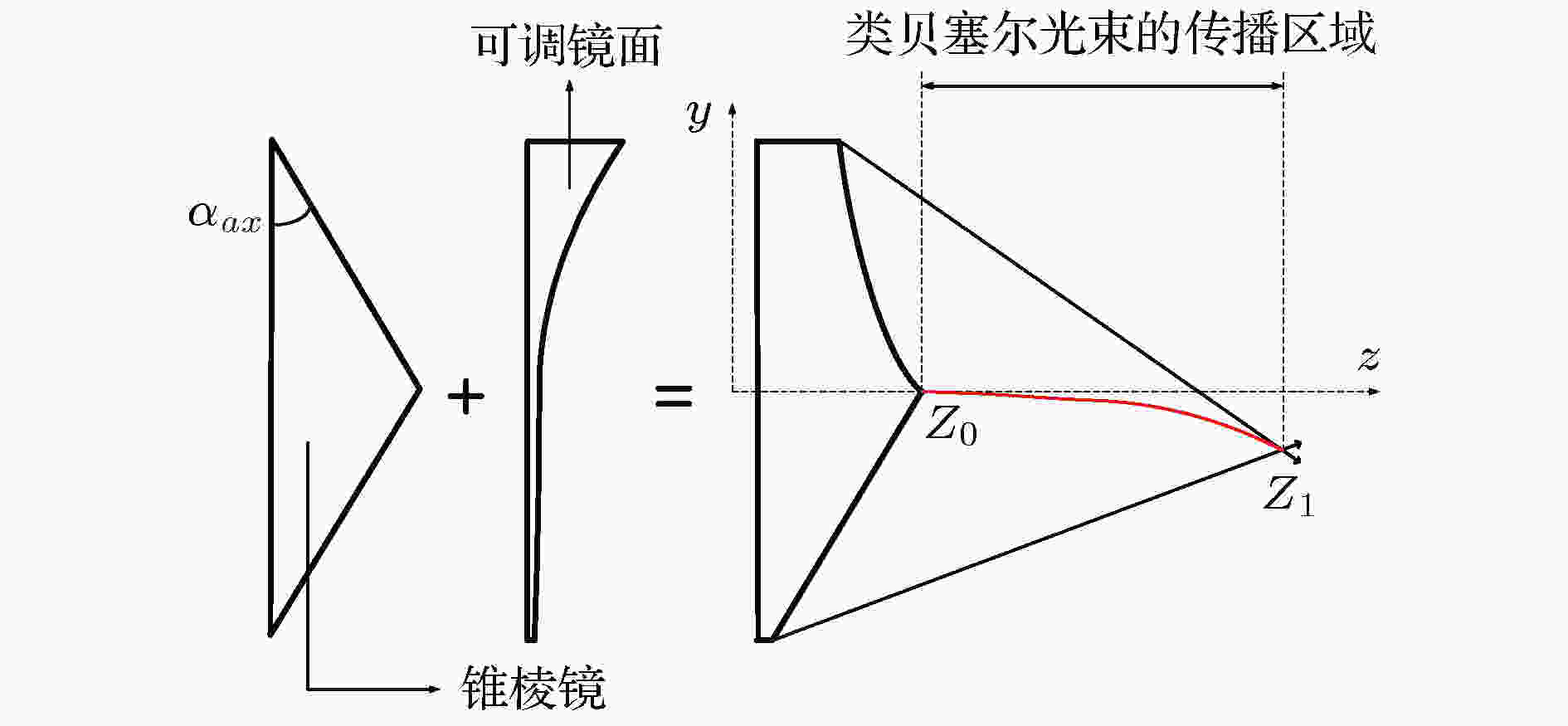
2019, 68 (11): 114701.
doi:10.7498/aps.68.20190063
Abstract +
CONDENSED MATTER: STRUCTURAL, MECHANICAL, AND THERMAL PROPERTIES
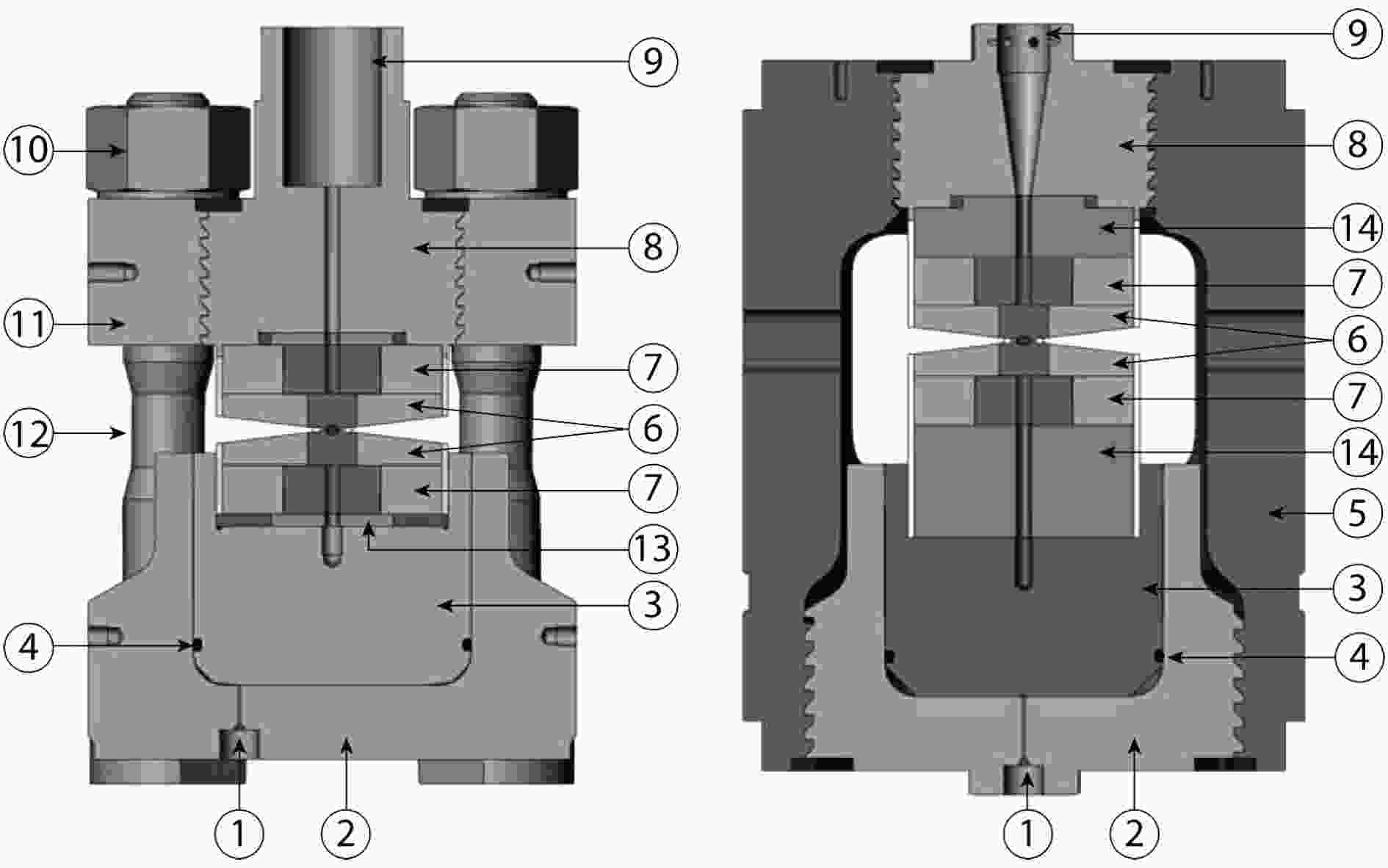
2019, 68 (11): 116101.
doi:10.7498/aps.68.20190179
Abstract +
Since the 1990s, with the benefit of available large-volumed samples, wide detector windows, and portability, Paris-Edinburgh press has been widely used in neutron facilities to study the structures and physical properties of condensed matter under high-pressure extreme conditions. In the present study, We perform high-pressure neutron diffraction experiments in neutron source of China using the Paris-Edinburgh press. The experiments are carried out on a high-pressure neutron diffraction spectrometer (Fenghuang) at China Mianyang Research Reactor (CMRR). Fenghuang is a high-intensity and moderate-resolution diffractometer which has been upgraded from a neutron powder diffractometer and can be used under ambient and extreme conditions. A single cylinder pump with a max load of 200 MPa provides a loading pressure for Paris-Edinburgh press, and a precise mobile platform is used to hang and to locate the Paris-Edinburgh press. Using the tungsten-carbide (WC) toroidal anvils with TiZr gasket, we obtain the neutron diffraction spectra of Fe samples at different pressures successfully. We also obtain the neutron diffraction spectra respectively at pressures of 9.7 GPa and 10.7 GPa by using a WC single-toroidal anvil and a WC double-toroidal anvil under load 100 MPa. The TiZr gasket blows out before the load reaches 100 MPa in the WC single-toroidal anvil assembly, while it remains good in the WC double-toroidal anvil assembly under the same load. The WC single-toroidal anvil assembly becomes unstable under load about 80 MPa, and the WC double-toroidal anvil assembly is still stable under load 100 MPa. Thus, the stability of the double-toroidal anvil assembly is much higher than that of the single-toroidal anvil assembly. It is found that the thickness of the gasket edge is very important for the stability of the assembly during loading. The thicker the edge of the gasket, the more stable the assembly is. The main reason is that the groove of the double concave anvil can enhance the lateral support ability of the gasket, thereby making the double concave surface assembly more stable than the single concave surface assembly.
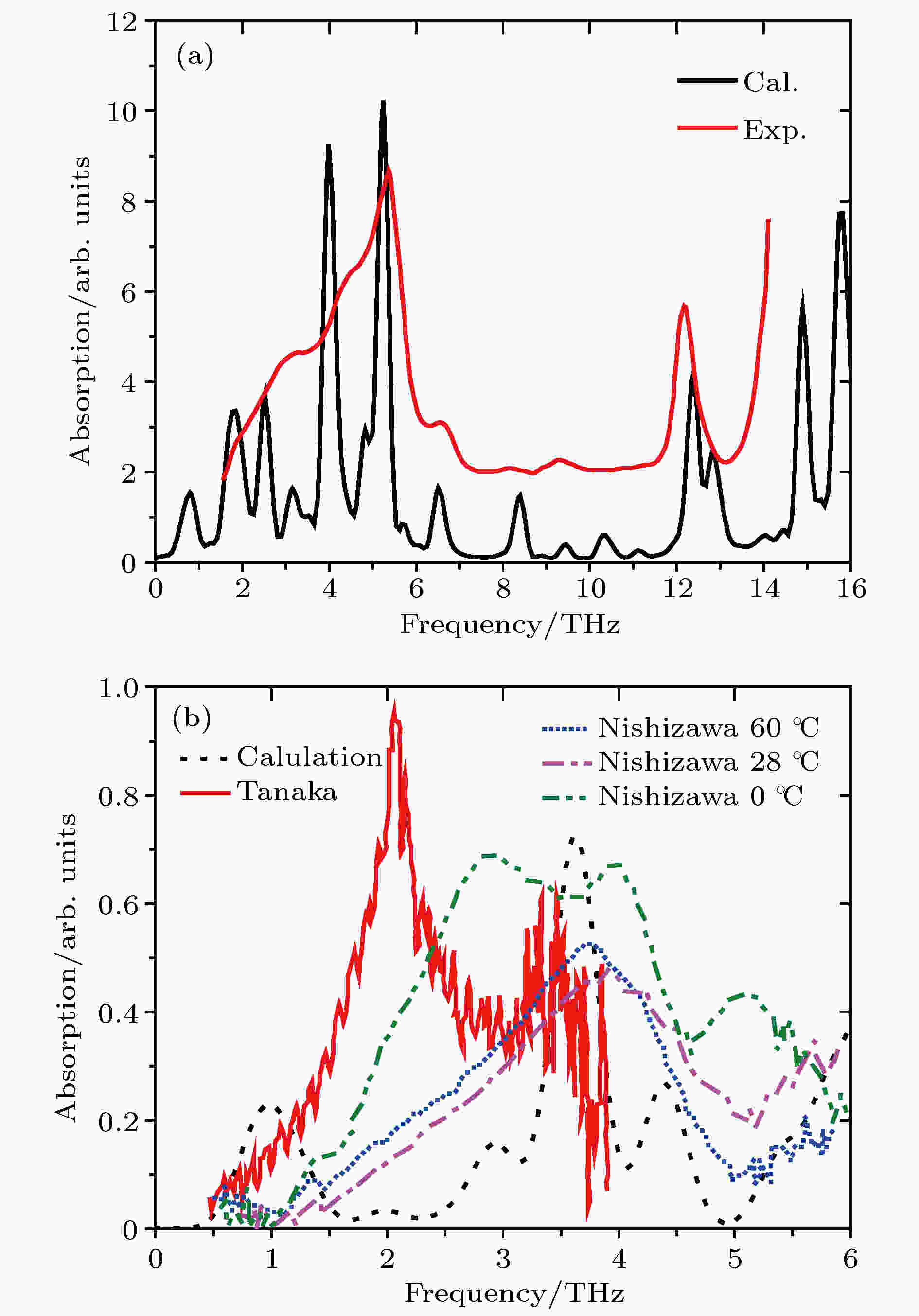
2019, 68 (11): 116102.
doi:10.7498/aps.68.20190209
Abstract +
According to density functional theory, in this paper we report a simulation result obtained by using the Gaussian09 package. Adopted in the calculation are an optimized Opt Freq and a base group of B3LYP/6-311g to simulate the absorption of 16 kinds of liquid crystal (LC) molecules of 4-(trans-4-n-alkylcyclohexyl) isothiocyanatobenzenes (CHBT) in a 0.1−5.0 terahertz band (THz). The results show that in the low terahertz band, the absorption is caused mainly by the vibration and rotation of the molecules. So for convenience, we present an novel analytical method of studying the influence of molecular moment of inertia and mass center of gravity shift on absorption. An important result is found that the length of the molecular alkyl chain can lead to different molecular mass, mass center of gravity and moment of inertia, which causes the rotation and vibration of the molecule to be different. These factors lead to the difference in terahertz wave absorption. In the 0.1−5.0 terahertz band, the molecules with 3−7 alkyl chain carbon atoms show a strong absorption. As a reference, reducing and increasing the carbon atoms in the alkyl chain will cause the molecules to reduce the absorption of terahertz waves . In the end, the calculated results are compared with the experimental results obtained from 10 molecules according to the reference data in a frequency range of 0.3−3.0 terahertz. It is found that in the low frequency band there exist some differences between the calculation results and the experimental measurements, in which the difference in the position of the absorption peak may originate from a hydrogen bond. Comparing the relative magnitudes of the absorption intensities, it is found that the experimental measurements are consistent with the calculated results, indicating that the absorption intensity comes from the absorption of dipole vibration and rotation, which demonstrates the positive significance of computational simulation. We look forward to the experimental measurements in the future, and correct the calculation methods and keywords as well as the parameters such as temperature calculation that is to be done in future work. As a theoretical basis, the calculation results can better reflect the absorption of molecular materials, and it is expected to provide useful suggestions for designing and synthesizing the liquid crystal molecules.
CONDENSED MATTER: ELECTRONIC STRUCTURE, ELECTRICAL, MAGNETIC, AND OPTICAL PROPERTIES
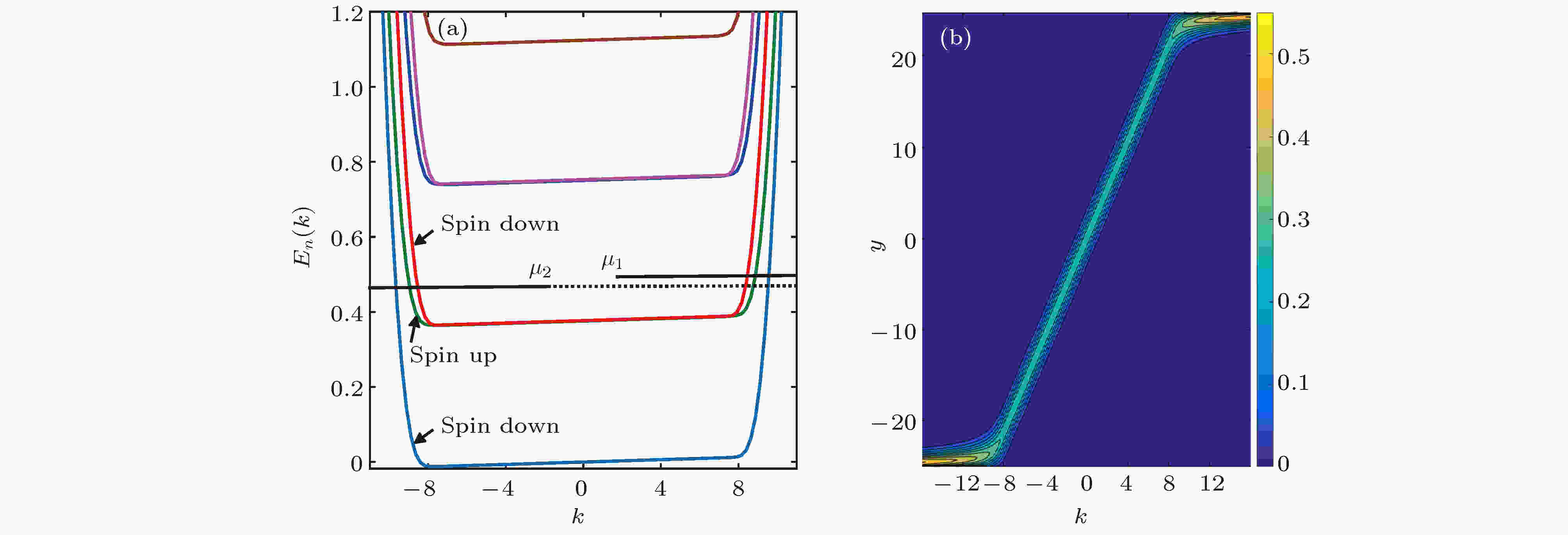
2019, 68 (11): 117101.
doi:10.7498/aps.68.20190037
Abstract +
Electron transport mechanism of a two-dimensional infinite slab subjected to Rashba spin-orbital coupling is studied in this paper. We calculate the Hall conductance and the longitudinal resistance of the integer quantum Hall effect (IQHE). In a strong magnetic field, the Landau levels of electrons increase rapidly at large wave vectors due to the constraint of the two edges of the sample while they remain flat at small wave vectors. Although the Zeeman effect can split the energy levels of spin degeneracy under a strong magnetic field, the spacing between the Landau levels is exactly equal to the spin splitting, thus the spin degeneracies have not been fully resolved. The spin-orbital coupling fully resolves the spin degeneracies of the energy levels. This is the key to reproducing the IQHE. Electrons with rapid increasing energies are localized at the two edges of the sample and transport along the edges to form separated currents with opposite directions. In this case, back scattering of electrons is prohibited due to the localization of these two branches. Since the electrons on the upper and lower edges originate respectively from the left and right electrode, they also have the chemical potentials of the electrons in those electrodes, respectively. The computation result shows that the Hall conductance appears as plateaus at integer times ofe2/h. Temperature influences the accuracy of the Hall plateaus. As an international resistance standard, exceeding a critical temperature can produce significant errors to the Hall plateaus. Below the critical temperature, the accuracy can reach 10–9. Finally the mechanism of the longitudinal resistance of the IQHE is discussed and computed numerically. It is shown that only the wave-functions with opposite and small wave vectors have a significant overlap in the bulk of the sample and thus contribute to the longitudinal resistance. Due to the separation of currents in different directions in space, the longitudinal resistance does vanish at the Hall plateaus but it appears when the Hall conductance jumps from one plateau to another one.
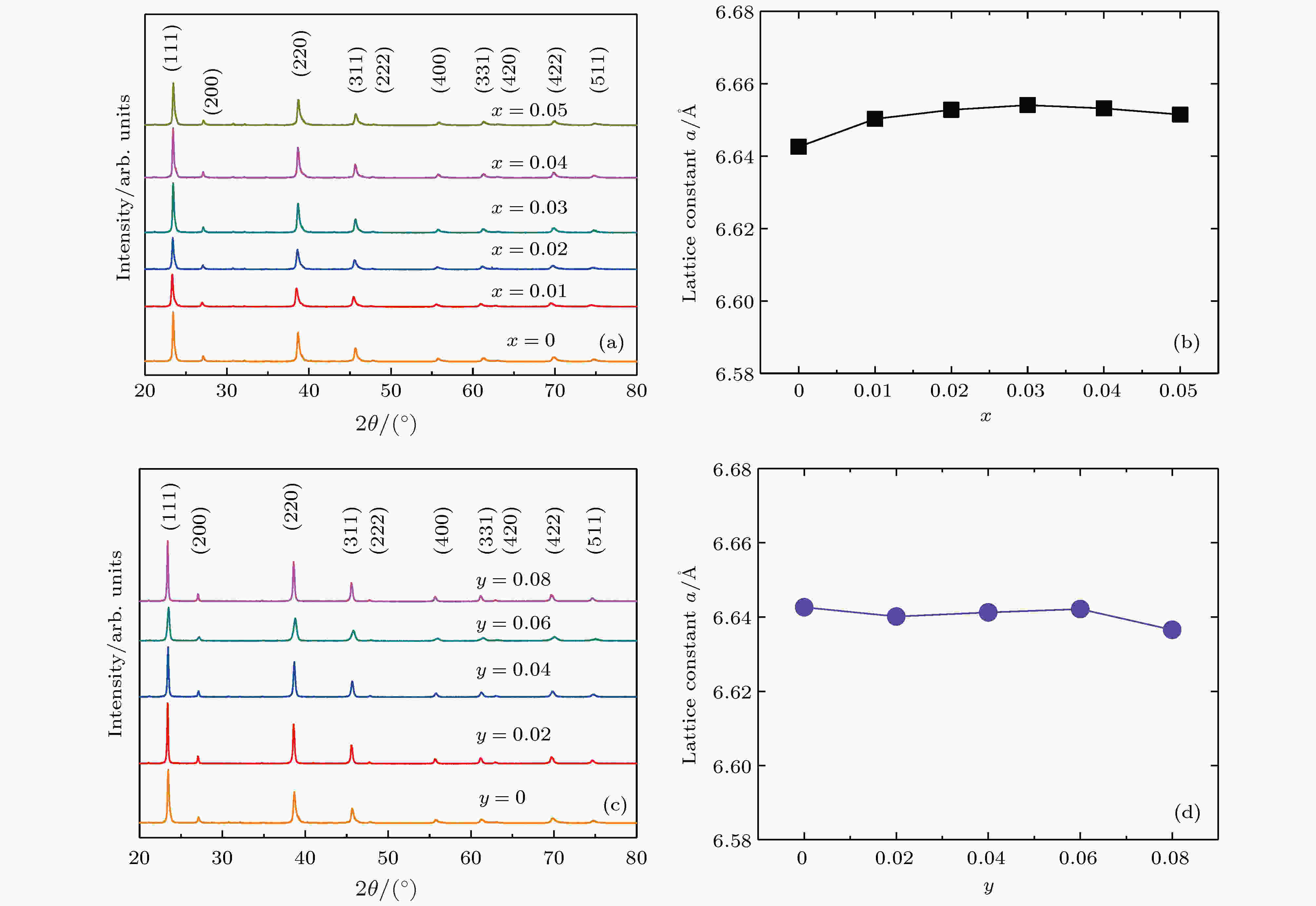
2019, 68 (11): 117201.
doi:10.7498/aps.68.20190247
Abstract +
In recent decades, Mg2(Si, Sn) solid solutions have long been considered as one of the most important classes of eco-friendly thermoelectric materials. The thermoelectric performance of Mg2(Si, Sn) solid solutions with outstanding characteristics of low-price, non-toxicity, earth-abundant and low-density has been widely studied. The n-type Mg2(Si, Sn) solid solutions have achieved the dimensionless thermoelectric figure of meritZT~1.4 through Bi/Sb doping and convergence of conduction bands. However, the thermoelectric performances for p-type Mg2(Si, Sn) solid solutions are mainly improved by optimizing the carrier concentration. In this work, the thermoelectric properties for p-type Mg2Si0.3Sn0.7are investigated and compared with those for different p-type dopant Ag or Li. The homogeneous Mg2Si0.3Sn0.7with Ag or Li doping is synthesized by two-step solid-state reaction method at temperatures of 873 K and 973 K for 24 h, respectively. The transport parameters and the thermoelectric properties are measured at temperatures ranging from room temperature to 773 K for Mg2(1–x)Ag2xSi0.3Sn0.7(x= 0, 0.01, 0.02, 0.03, 0.04, 0.05) and Mg2(1–y)Li2ySi0.3Sn0.7(y= 0, 0.02, 0.04, 0.06, 0.08) samples. The influences of different dopants on solid solubility, microstructure, carrier concentration, electrical properties and thermal transport are also investigated. The X-ray diffraction (XRD) patterns and scanning electron microscopy (SEM) images show that the solid solubility for Ag and for Li arex= 0.03 andy= 0.06, respectively. Based on the assumption of single parabolic band model, the value of effective mass ~1.2m0of p-type Mg2(1–x)Ag2xSi0.3Sn0.7and Mg2(1–y)Li2ySi0.3Sn0.7are similar to that reported in the literature. The comparative results demonstrate that the maximum carrier concentration for Ag doping and for Li doping are 4.64×1019cm–3forx= 0.01 and 15.1×1019cm–3fory= 0.08 at room temperature, respectively; the Li element has higher solid solubility in Mg2(Si, Sn), which leads to higher carrier concentration and power factorPF~1.62×10–3
${\rm W}\cdot{\rm m^{–1}}\cdot{\rm K^{–2}}$
in Li doped samples; the higher carrier concentration of Li doped samples effectively suppresses the bipolar effect; the maximum ofZT~0.54 for Mg1.92Li0.08Si0.3Sn0.7is 58% higher than that of Mg1.9Ag0.1Si0.3Sn0.7samples. The lattice thermal conductivity of Li or Ag doped sample decreases obviously due to the stronger mass and strain field fluctuations in phonon transport.
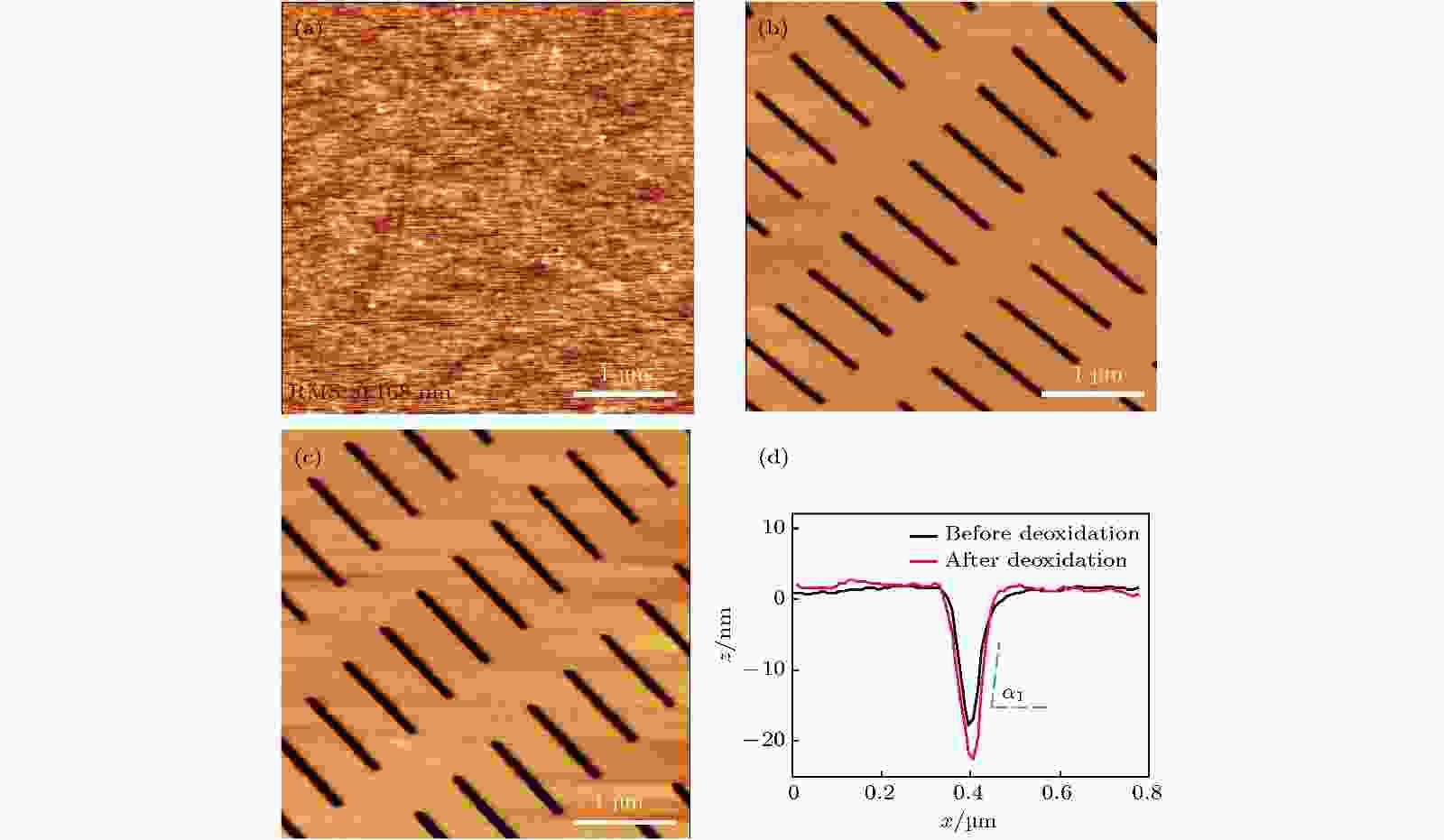
COVER ARTICLE
2019, 68 (11): 117301.
doi:10.7498/aps.68.20190317
Abstract +
InAs/GaAs quantum dot (QD) is one of the promising material systems for the quantum information processing due to their atomic-like optical and electrical properties. There are many previous researches reporting the InAs QDs which can be implemented as solid-state single-photon sources for quantum information and quantum computing. However, the site-controlled growth of QDs is the prerequisite for addressability and integration. There are very few researches focusing on the systematic study of preferential nucleation of InAs QDs on a patterned GaAs (001) substrate. In this work, we study the preferential nucleation sites of InAs QDs on a patterned GaAs (001) substrate with different trench sidewall inclinations. With small inclination angle of the trench sidewalls, the InAs QDs nucleate preferentially inside the trenches, while with large inclination angle, the edges of the trenches appear to be the preferential nucleation sites. By utilizing the established method, a pair of InAs dots can be uniformly achieved in the patterned pits through tuning the inclination angle of the pits. The site-controlled single InAs QD and InAs QD molecules on the patterned substrates could have potential applications in quantum information processing and quantum computing.
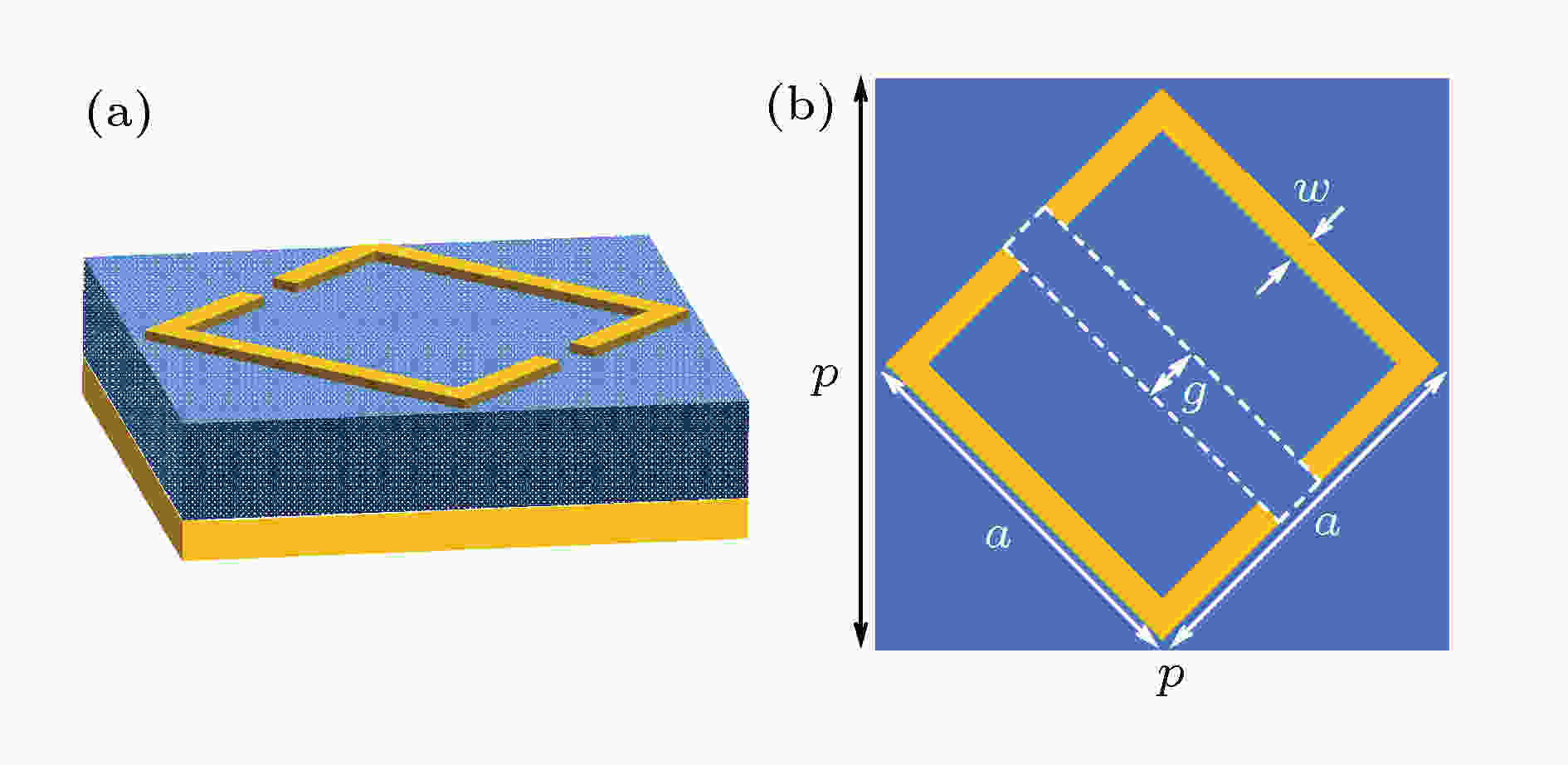
2019, 68 (11): 117801.
doi:10.7498/aps.68.20190267
Abstract +
INTERDISCIPLINARY PHYSICS AND RELATED AREAS OF SCIENCE AND TECHNOLOGY
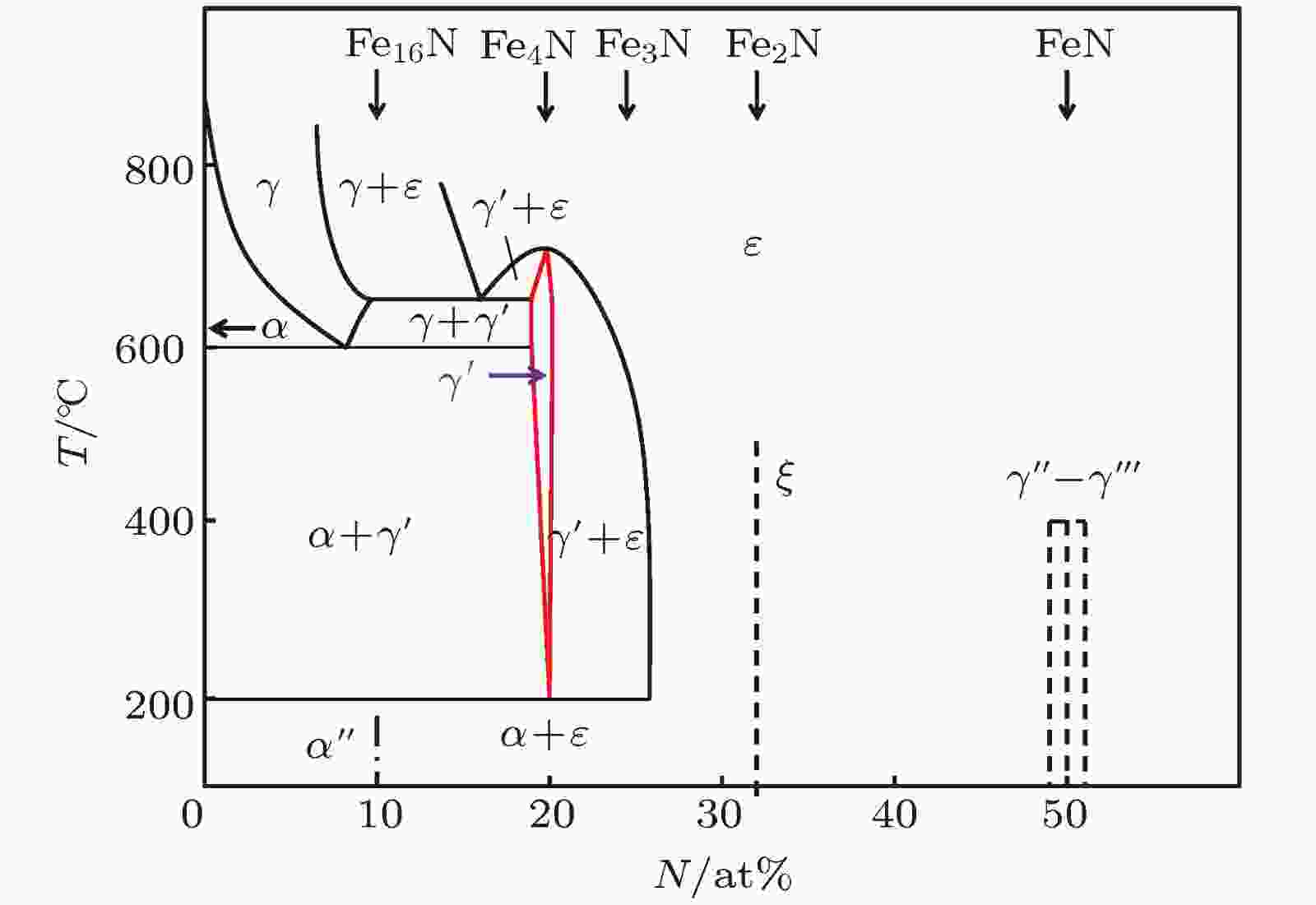
2019, 68 (11): 118101.
doi:10.7498/aps.68.20182195
Abstract +
The phase transition law of Fe-N system is very important for efficiently synthesizing single-phaseγ'-Fe4N thin films. Theγ"-FeN thin films are deposited on silicon wafers via DC reactive magnetron sputtering; some of them are stripped from the silicon wafers and measured by using the synchronous thermal analysis (TG-DSC) for studying the phase transition law of Fe-N system. The results of TG-DSC show that at a heating rate of 10 ℃/min, the Fe-N system has five phase transitions in a temperature range between room temperature (RT) and 800 ℃, i.e. I (330−415 ℃):γ''-FeN→ξ-Fe2N with an endothermic value of 133.8 J/g; II (415−490 ℃): ξ-Fe2N→ε-Fe3N with no obvious latent heat of phase change; III (510−562 ℃): ε-Fe3N→γ'-Fe4N with an exotherm value of 29.3 J/g; IV (590−636 ℃):γ'-Fe4N→γ-Fe with an exotherm value of 42.6 J/g; V (636−690 ℃):γ-Fe→α-Fe with an endothermic value of 14.4 J/g. According to the phase transition law of Fe-N system, the crystal phase of iron nitride thin film is effectively regulated by vacuum annealing. The x-ray diffraction pattern (XRD) results show that the iron nitride thin film obtained by direct-sputtering in pure N2is a single-phaseγ"-FeN film, and it becomes a single-phase ξ-Fe2N film after being annealed at 350 ℃ for 2 h, a single-phase ε-Fe3N film after being annealed at 380 ℃ for 2 h, and a single-phaseγ'-Fe4N film after being annealed at 430 ℃ for 7 h. The annealing temperature for the phase transition of Fe-N thin film is generally lower than that predicted by the TG-DSC experimental results, because it is affected by the annealing time too, that is, prolonging the annealing time at a lower temperature is also effective for regulating the crystal phase of Fe-N thin film. The magnetic properties of the Fe-N thin film are also studied via vibrating sample magnetometer (VSM) at room temperature. Theγ'-Fe4N polycrystalline thin film shows an easy-magnetized hysteresis loop for the isotropic in-plane one, but a hard-magnetized hysteresis loop with a large demagnetizing field for the out-of-plane one, which belongs to the typical magnetic shape anisotropy. However, their saturation magnetizations are really the same (about 950 emu/cm3) both in the plane and out of the plane.
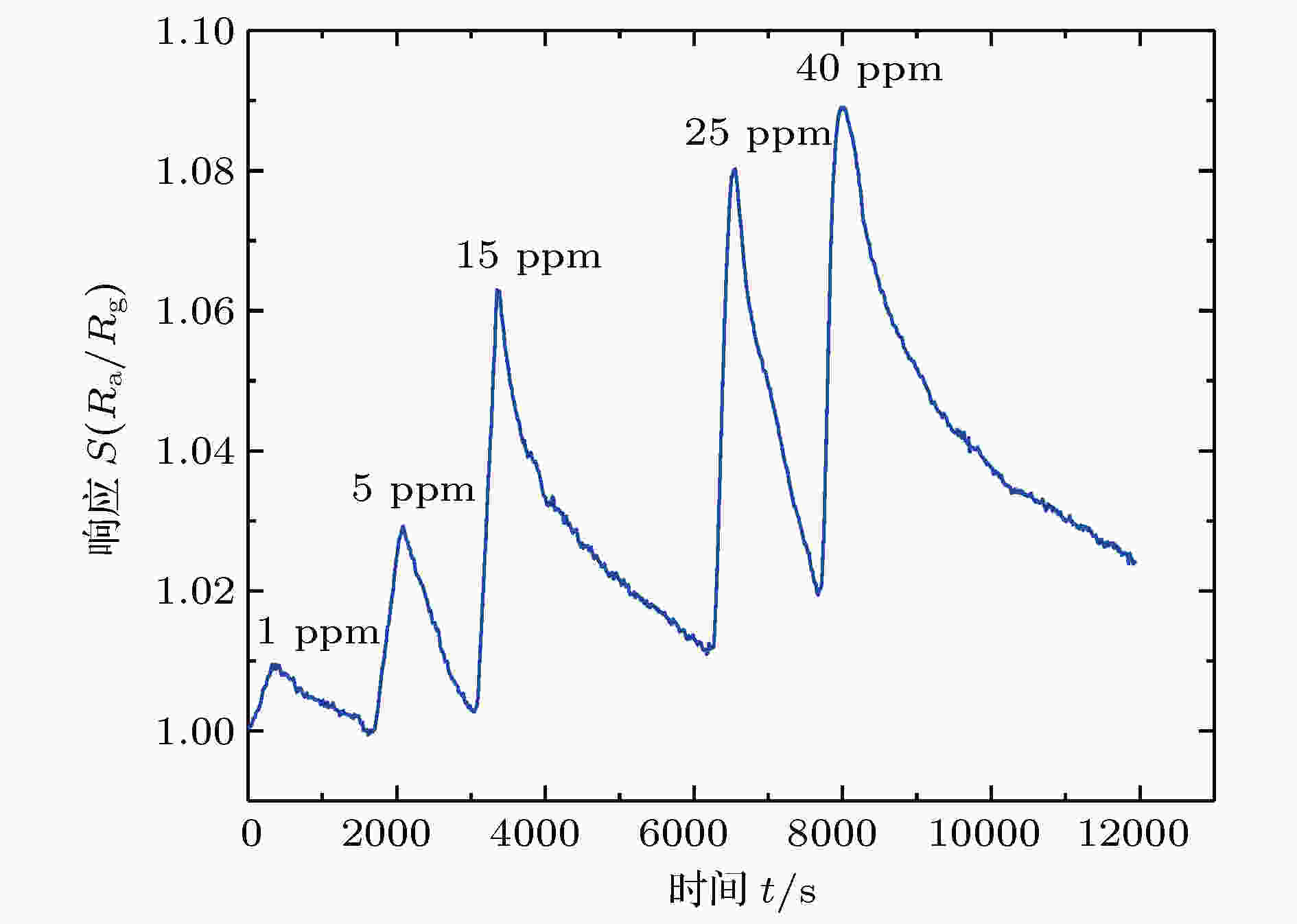
2019, 68 (11): 118102.
doi:10.7498/aps.68.20182242
Abstract +
Reduced graphene oxide, as a candidate for gas detection due to its unique atomic structure, is arousing the wide interest of researchers. In this paper, hydrazine hydrate is used to reduce graphene oxide prepared by the modified Hummers method. A chemical resistance gas sensor is fabricated. The prepared reduced graphene oxide is used as a gas sensitive layer of Au planar interdigital electrode. The gas sensing characteristics such as responsivity, recovery and repeatability of NO2gas are studied. The results show that the graphene oxide reduced by hydrazine hydrate can detect the NO2gas at a concentration of 1−40 ppm under room temperature. It has good responsivity and repeatability. The recovery rate can reach more than 71%. However, the sensitivity is only 0.00201 ppm–1, and there is much room for improvement. In addition, the response time and recovery time for NO2at 5 ppm concentration are 319 s and 776 s, respectively. The sensing mechanism of the hydrazine hydrate-reduced graphene oxide gas sensor can be attributed to charge transfer between the NO2molecule and the sensing material. The outstanding electrical properties of the reduced graphene oxide promote the electron transfer process. This allows the sensor to exhibit excellent gas sensing performance at room temperature. The reduced graphene oxide appears as a typical p-type semiconductor and the oxidizing gas NO2acts as an electron acceptor. Therefore, the adsorption of NO2gas leads to the enhancement of the hole density and conductivity of the reduced graphene oxide. Another reason is the presence of defects and oxygen-containing functional groups on graphene sheets. Some oxygen-containing groups remain on the graphene surface after an incomplete reduction reaction. Compared with pure graphene, the reduced graphene oxide has hydroxyl groups and epoxy groups remaining on the surface. These functional groups will functionalize the material and promote the adsorption of gases. At the same time, the reduction reaction will further produce vacancies and structural defects. This will provide more reaction sites and thus conduce to the material further adsorbing the gas. In summary, the experimental research in this paper is of significance for studying the mechanism and characteristics of the reduced graphene oxide by using hydrazine hydrate as a reducing agent, and it can provide reference and lay a foundation for the applications of future graphene sensors.
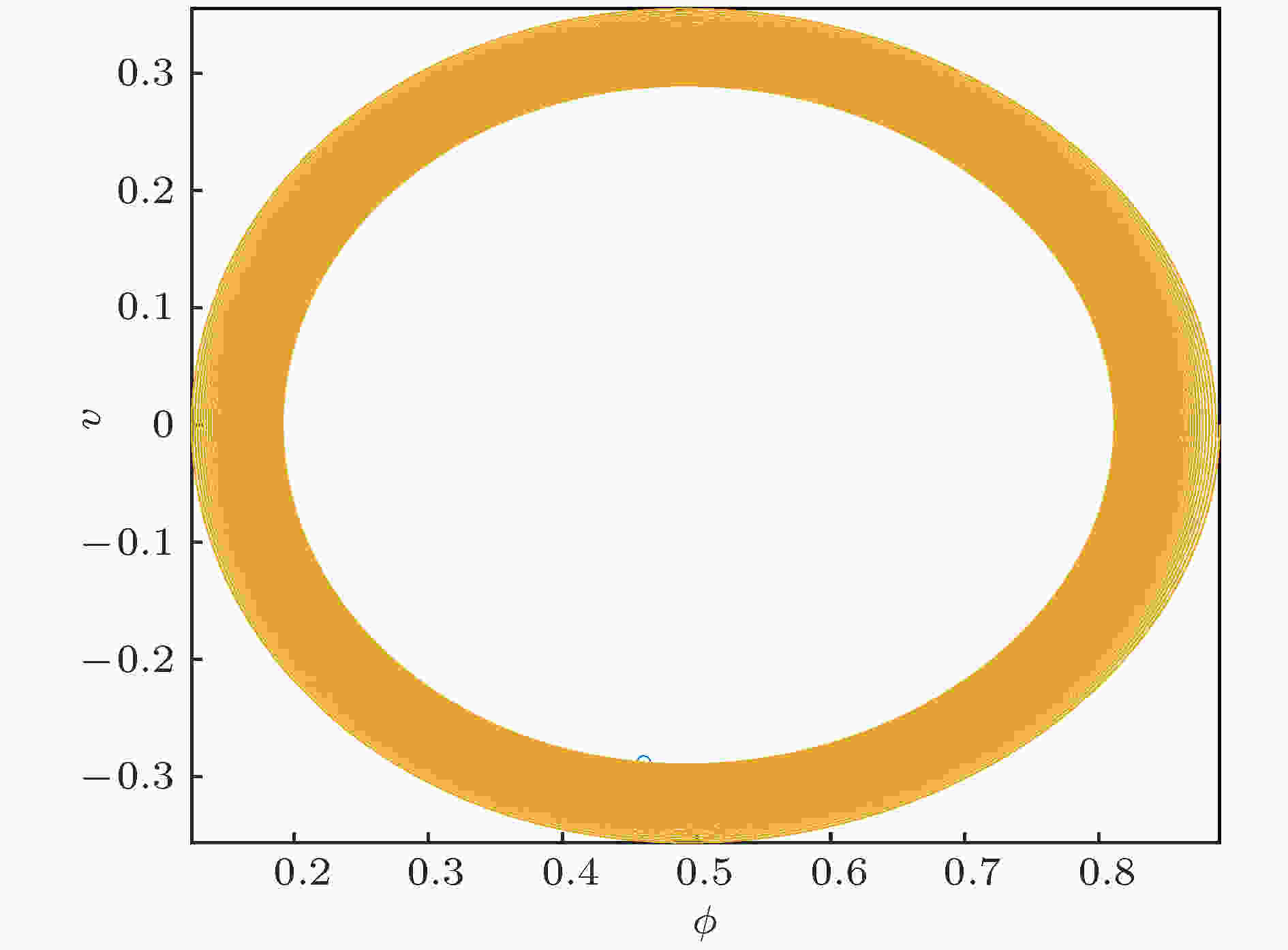
2019, 68 (11): 118501.
doi:10.7498/aps.68.20190167
Abstract +
Based on Josephson junction (JJ), superconducting quantum bit (qubit) is operated at frequencies of several GHz. Dissipation of JJs in this frequency range can cause energy relaxation in qubits, and limit coherence time, therefore it is highly concerned and needs to be determined quantitatively. The dissipation of JJs can be quantified by microwave quality factor. It is usually done at very low temperature (~mK) to determine whether a JJ is suitable for qubit devices by measuring the quality factor. In this paper, a method based on nonlinear frequency response of JJs is proposed to determine the quality factor. This method can be used in thermal activation regime, which may bring great conveniences to experiments. To analyze high frequency properties of JJs, the dynamic equation of a current-biased JJ, which describes high frequency oscillation of the JJ, is introduced. A fourth-order potential approximation is used to obtain the analytical equation of non-linear response. The dependence on quality factor, as well as on amplitude, of difference between JJ’s plasma frequency and resonant frequency, is derived from the equation. The approximate treatment is quantitatively validated by our numerical simulations with practical JJ parameters including different environment influences. Thus, based on nonlinear frequency response of JJs, a reliable and simple method to determine quality factor of JJ is proposed, which is desirable for exploring JJ based microwave devices such as parametric amplifier, superconducting qubit. Being driven well into the nonlinear microwave response regime, due to frequency-amplitude interaction, the resonant frequency of a current bias JJ deviates from the JJ’s plasma frequency. The deviation is directly related to the microwave quality factor. Hence, the quality factor can be deducted from the experimental measurement of the resonant frequency deviation, with different microwave power values applied. In comparison with linear resonance experiment, the nonlinear resonance used by the proposed method produces stronger signal. Therefore it is more robust against external noise. When being conducted at high temperature, the proposed method is more reliable. The accuracy of the measured quality factor primarily depends on those of the JJ’s parameters such as critical current and capacitance, while those parameters can be experimentally determined with high precision.
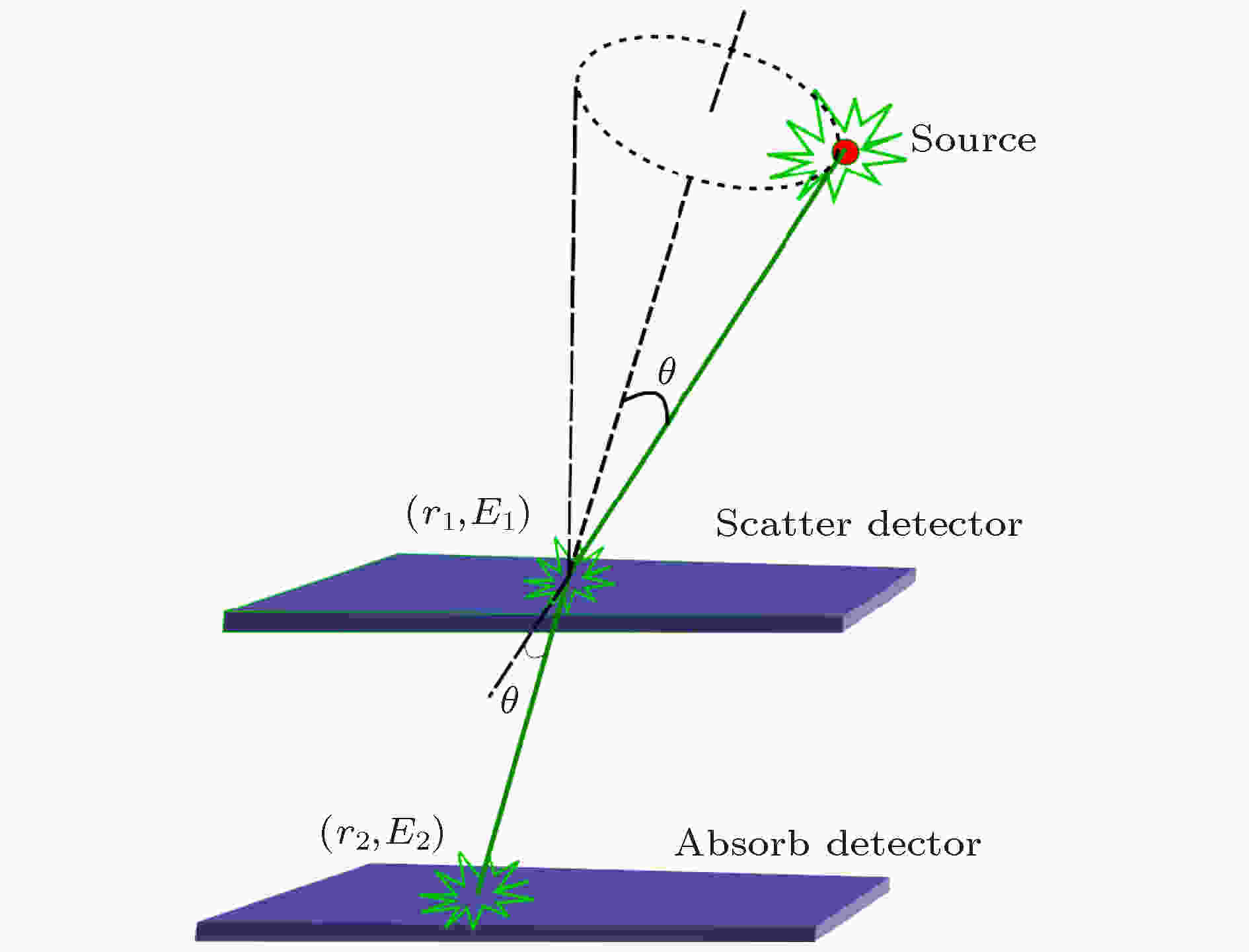
2019, 68 (11): 118701.
doi:10.7498/aps.68.20182245
Abstract +
Compared with traditional gamma-ray imaging equipment, the Compton camera is a very promising imaging device in nuclear medicine and molecular imaging, and has a strong potential application in monitoring beams in heavy-ion-therapy because of its high efficiency feature. A demonstration device for heavy ion cancer treatment with complete intellectual property right has been built at Institute of Modern Physics, Chinese Academy of Sciences in Wuwei city of Gansu Province. At present the device is being up-graded, and the heavy ion cancer treatment is being generalized in national wide. In view of the broad prospects of heavy ion cancer treatment, the imaging resolution of Compton camera is analyzed theoretically, and three errors effecting the imaging resolution, which are energy resolution, position resolution of detector and the Doppler effect, are determined. Then the three errors are simulated by using the Geant 4 packages. The physical process in simulation is selected as the G4EMPenelopePhysics model, which makes the atomic shell cross section data for low energy physical process used directly. The Compton camera geometry consists of two layers of detectors. The layer close to
$\gamma$
source is called detector and the other one is called absorption detector. The material of scatter detector is selected as low-Zsilicon and carbon, and the absorb detector is high-Zgermanium. The thickness value of scatter detector and absorb detector are both 20 mm. The spacing between the two layers is 100 mm. The simulation results by Geant 4 are used to reconstruct the image of point-like
$\gamma$
source through using the back-projection algorithm. The simulation results and the re-constructed images indicate that the difference between the image full width at half maximum induced by 2 mm position resolution and that induced by 5.0% relative energy resolution of scatter detector is about 10%, and amount to that by the Doppler effect of Silicon. For the
$\gamma$
ray with energies of several hundred keV, the energy resolution of Si detectors is easily better than 1.0% in practice. Therefore, the detector's position resolution dominates the image quality of the Compton camera. Considering the Doppler effect, manufacturing techniques and imaging efficiency, 2.0 mm-sized crystal unit and 1.0% energy resolution power is suggested for practically manufacturing the Compton camera.
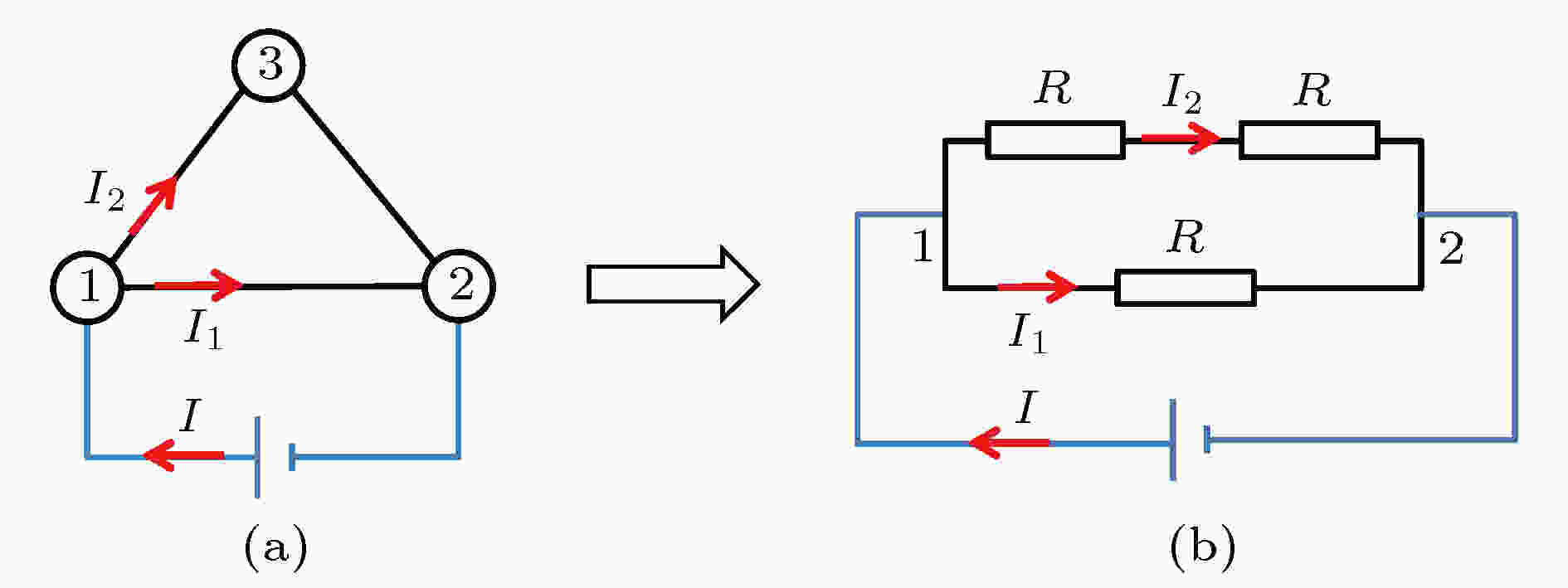
2019, 68 (11): 118901.
doi:10.7498/aps.68.20190230
Abstract +
Optimization of the network’s electrical transport properties not only conduces to understanding the relationship between structure and network function, but also can improve the electrical engineering technology. The effective way to solve this problem is to treat the network from the information viewpoint and seek the information structure measure which affects crucially the network electrical transport performance. Recent studies have shown that the communicability sequence entropy of complex networks can effectively quantify the global structural information of networks. Based on this measure, the difference between networks can be quantified effectively, and the connotation of communicability sequence entropy is explained. In this paper, we predict that the electrical transport performance of complex networks has a strong correlation with the communicability sequence entropy. For this reason, we mainly study the correlation characteristics of the electrical transport performance and communicability sequence entropy of small-world networks, scale-free networks, degree-correlated scale-free networks, community networks, and IEEE57 and other electrical node networks. The results show that the electrical transport performances of these networks are all a monotonically increasing function of communicability sequence entropy, namely, the communicability sequence entropy, and the electrical transport properties have a positive correlation. Specifically, in the process evolving from a regular network to a small-world network, the communicability sequence entropy and electrical transport performance of the network increase gradually. For scale-free networks, in the process of increasing degree distribution exponent, communicability sequence entropy and electrical transport performance of the network increase gradually. For degree-correlated scale-free networks, during the evolution from assortative to disassortative topology, communicability sequence entropy and electrical transport performance both decrease gradually. For networks with community structure, the communicability sequence entropy and electrical transport performance decrease with the increase of the number of communities. Finally, the correlation between communicability sequence entropy and electrical transport performance of two classical node power supply networks and corresponding randomization network models are also studied. The results show that as the order ofdincreases, both communicability sequence entropy and electrical transport performance decrease. And both are getting closer to the original network's communicability sequence entropy and electrical transport performance. The rule is beneficial to providing an effective strategy for designing a high transmission efficiency of the power network, that is, we can optimize the electrical transport performance by improving the network communicability sequence entropy.

2019, 68 (11): 118902.
doi:10.7498/aps.68.20182254
Abstract +
Entering the information era, the formation of public opinion is largely associated with the complex system constructed by the Internet, thereby possessing new characteristics. The formation of public opinion is the result of the interaction of individual behavior with social environment. In reality, the environmental factor and the individual behavior are usually related to each other and co-evolve with time. Based on the Ising model, in this paper established is an opinion formation model that includes the process of the accumulation and digestion of the social tension. In the model, a parameter named effective dissolving factorcis designed to represent the extent of the interaction between the system and the social environment. A two-dimensional dynamical system is involved in the model to describe the dynamics of individual behavior and social tension. The co-evolution behavior of the system is studied. Based on the Landau mean field theory, the stationary states of the dynamical system under different parameter values, i.e. the value of effective dissolving factorc, their stability and bifurcation of the system, are analyzed. Finally, the computer simulation method is used to verify the results. The research shows that with the co-evolution mechanism of the system, our model exhibits certain self-organization characteristics. When the effective dissolving factorcis smaller than the threshold value, the system will reach final consensus opinion, resulting in a macroscopically ordered state. Otherwise, when the dissolving factorcexceeds a threshold value, the system is stable in the disordered state. It is interesting to find that there is such a critical value of the parameter that it leads the system to be self-organized into a critical state from any initial state. The future detailed investigation on the criticality of the co-evolving system is also suggested, such as testing whether the system has evolved into the critical state according to the finite-sized scaling theory and calculating the critical exponent of the system. In addition, in this paper provided is a new perspective to tackle practical problems in public opinion. Based on the mechanism of the formation of public opinion revealed by our model, researchers are encouraged to conduct studies on how to monitor the state of public opinion more precisely and to predict the tipping point of the system evolution.










